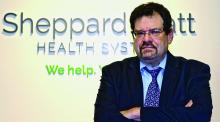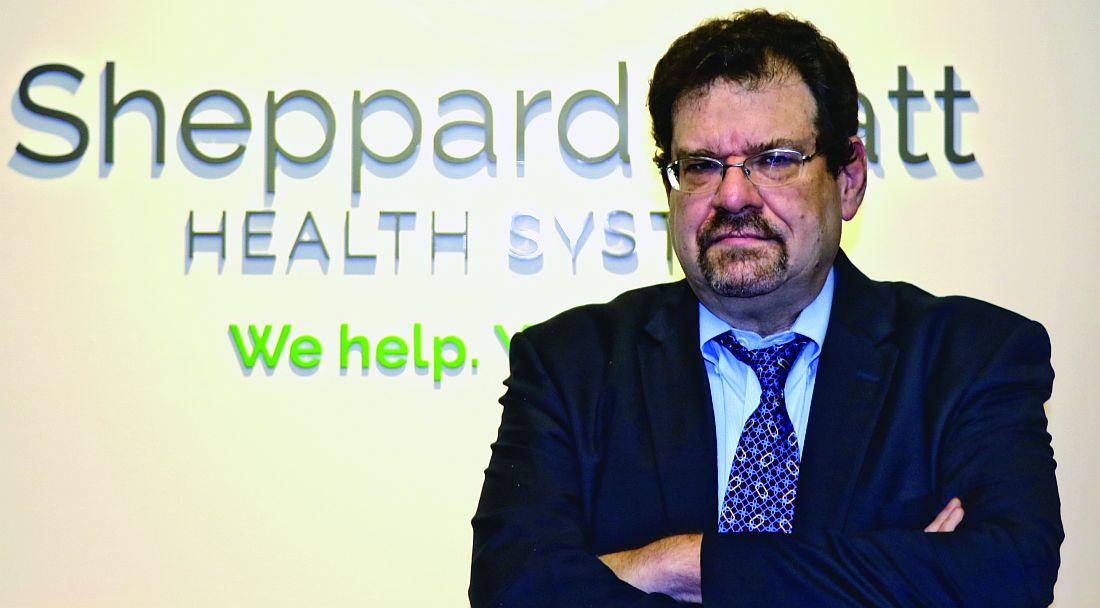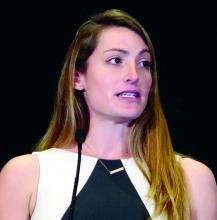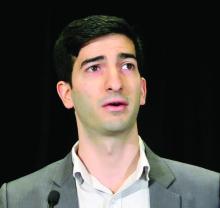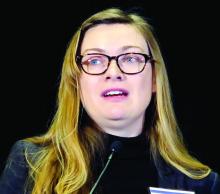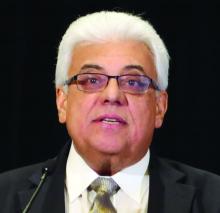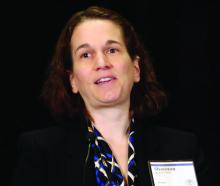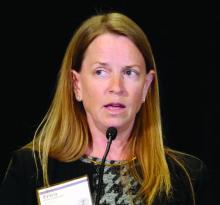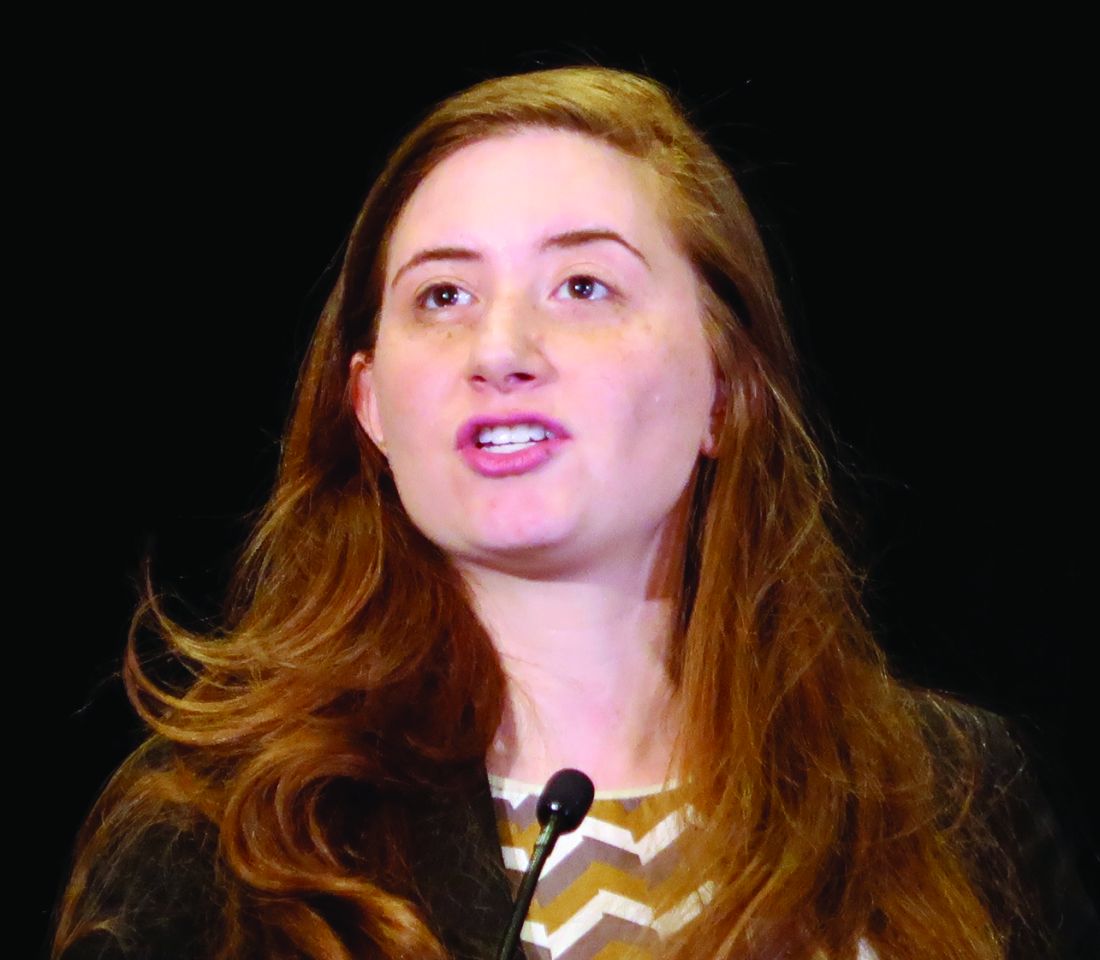User login
Work-life balance is not a ‘thing’ but alignment is
We are destined to fail at achieving work-life balance because it does not exist, nor has it ever existed, according to an expert on how people experience time.
The field of chronemics studies the space between people, namely how they communicate with others and with themselves as they experience life in a matrix, not just linearly.
“When we talk about time, we need to remember that context and communication really matter,” Dawna Ballard, PhD, a chronemics expert and associate professor of communication at the University of Texas at Austin, said during a session Tuesday. “We think of our concept of time as ‘truth,’ but when we experience other cultures, often we see they don’t function according to our idea of time.”
The modern concept of time as told by a clock was invented during the Industrial Age to control people and events by forcing a direct line between their lives outside the factory and the farm, according to Dr. Ballard. That is not to say that industrial time is bad. It is efficient and perhaps even necessary for organizing large groups of people, she said.
Time management as a concept evolved out of the ethos of “punching the clock” at the factory, but has carried over to the office where in fact, according to Dr. Ballard, people do not tend to be as effective if they are expected to work in a linear way, since that is not the experience in today’s digital world where interruptions are common. In a survey of 1,000 people, after researchers subtracted the time people spend on email, social media, and other digital interruptions, only 3½ hours of the typical 8-hour work day were left for actual work, and these remaining hours were not consecutive, Dr. Ballard noted.
“In reality, we operate in relationship to time more like we did in preindustrial times than we did during industrial times,” said Dr. Ballard. “Medicine has always had that approach, but the management of it is by people who are still being trained according to industrial [notions] of time.”
The resulting cognitive dissonance contributes to people experiencing guilt for not “balancing” their day properly, according to Dr. Ballard. Because to balance something means separating the pieces and quantifying them separately, people whose lives interrupt them throughout the work day find themselves thinking they have “failed” at achieving a work/life balance, when what they really have done is experience their life as it actually is. “No one likes to feel like a failure, particularly people who are high achievers and who expect to have agency over their lives.”
Dr. Ballard said that an alternative to seeing work and life as components that must be balanced is to instead view these things as being in an alignment that can shift over time. She also suggested challenging the accepted notions of what being productive really means in the context of how one’s life actually is, and to occasionally put down the smartphone and consciously practice experiencing time in an unstructured way.
We are destined to fail at achieving work-life balance because it does not exist, nor has it ever existed, according to an expert on how people experience time.
The field of chronemics studies the space between people, namely how they communicate with others and with themselves as they experience life in a matrix, not just linearly.
“When we talk about time, we need to remember that context and communication really matter,” Dawna Ballard, PhD, a chronemics expert and associate professor of communication at the University of Texas at Austin, said during a session Tuesday. “We think of our concept of time as ‘truth,’ but when we experience other cultures, often we see they don’t function according to our idea of time.”
The modern concept of time as told by a clock was invented during the Industrial Age to control people and events by forcing a direct line between their lives outside the factory and the farm, according to Dr. Ballard. That is not to say that industrial time is bad. It is efficient and perhaps even necessary for organizing large groups of people, she said.
Time management as a concept evolved out of the ethos of “punching the clock” at the factory, but has carried over to the office where in fact, according to Dr. Ballard, people do not tend to be as effective if they are expected to work in a linear way, since that is not the experience in today’s digital world where interruptions are common. In a survey of 1,000 people, after researchers subtracted the time people spend on email, social media, and other digital interruptions, only 3½ hours of the typical 8-hour work day were left for actual work, and these remaining hours were not consecutive, Dr. Ballard noted.
“In reality, we operate in relationship to time more like we did in preindustrial times than we did during industrial times,” said Dr. Ballard. “Medicine has always had that approach, but the management of it is by people who are still being trained according to industrial [notions] of time.”
The resulting cognitive dissonance contributes to people experiencing guilt for not “balancing” their day properly, according to Dr. Ballard. Because to balance something means separating the pieces and quantifying them separately, people whose lives interrupt them throughout the work day find themselves thinking they have “failed” at achieving a work/life balance, when what they really have done is experience their life as it actually is. “No one likes to feel like a failure, particularly people who are high achievers and who expect to have agency over their lives.”
Dr. Ballard said that an alternative to seeing work and life as components that must be balanced is to instead view these things as being in an alignment that can shift over time. She also suggested challenging the accepted notions of what being productive really means in the context of how one’s life actually is, and to occasionally put down the smartphone and consciously practice experiencing time in an unstructured way.
We are destined to fail at achieving work-life balance because it does not exist, nor has it ever existed, according to an expert on how people experience time.
The field of chronemics studies the space between people, namely how they communicate with others and with themselves as they experience life in a matrix, not just linearly.
“When we talk about time, we need to remember that context and communication really matter,” Dawna Ballard, PhD, a chronemics expert and associate professor of communication at the University of Texas at Austin, said during a session Tuesday. “We think of our concept of time as ‘truth,’ but when we experience other cultures, often we see they don’t function according to our idea of time.”
The modern concept of time as told by a clock was invented during the Industrial Age to control people and events by forcing a direct line between their lives outside the factory and the farm, according to Dr. Ballard. That is not to say that industrial time is bad. It is efficient and perhaps even necessary for organizing large groups of people, she said.
Time management as a concept evolved out of the ethos of “punching the clock” at the factory, but has carried over to the office where in fact, according to Dr. Ballard, people do not tend to be as effective if they are expected to work in a linear way, since that is not the experience in today’s digital world where interruptions are common. In a survey of 1,000 people, after researchers subtracted the time people spend on email, social media, and other digital interruptions, only 3½ hours of the typical 8-hour work day were left for actual work, and these remaining hours were not consecutive, Dr. Ballard noted.
“In reality, we operate in relationship to time more like we did in preindustrial times than we did during industrial times,” said Dr. Ballard. “Medicine has always had that approach, but the management of it is by people who are still being trained according to industrial [notions] of time.”
The resulting cognitive dissonance contributes to people experiencing guilt for not “balancing” their day properly, according to Dr. Ballard. Because to balance something means separating the pieces and quantifying them separately, people whose lives interrupt them throughout the work day find themselves thinking they have “failed” at achieving a work/life balance, when what they really have done is experience their life as it actually is. “No one likes to feel like a failure, particularly people who are high achievers and who expect to have agency over their lives.”
Dr. Ballard said that an alternative to seeing work and life as components that must be balanced is to instead view these things as being in an alignment that can shift over time. She also suggested challenging the accepted notions of what being productive really means in the context of how one’s life actually is, and to occasionally put down the smartphone and consciously practice experiencing time in an unstructured way.
VIDEO: SHM seeks sites to test pediatric transition tool
Would you like to help the Society of Hospital Medicine translate its award-winning Project BOOST® Mentored Implementation Program into the pediatric setting?
“We’re hoping to get six sites to help us implement this project so we can collect data and see how well it works for pediatrics,” James O’Callaghan, MD, medical director, EvergreenHealth, Seattle Children’s, said in an interview.
In this video, recorded during HM17 , Dr. O’Callaghan describes how Pedi-BOOST is intended to work, and what types of pediatric transition concerns it is intended to address.
For more information, please visit the SHM website.
Dr. O’Callaghan had no relevant disclosures.
The video associated with this article is no longer available on this site. Please view all of our videos on the MDedge YouTube channel
Would you like to help the Society of Hospital Medicine translate its award-winning Project BOOST® Mentored Implementation Program into the pediatric setting?
“We’re hoping to get six sites to help us implement this project so we can collect data and see how well it works for pediatrics,” James O’Callaghan, MD, medical director, EvergreenHealth, Seattle Children’s, said in an interview.
In this video, recorded during HM17 , Dr. O’Callaghan describes how Pedi-BOOST is intended to work, and what types of pediatric transition concerns it is intended to address.
For more information, please visit the SHM website.
Dr. O’Callaghan had no relevant disclosures.
The video associated with this article is no longer available on this site. Please view all of our videos on the MDedge YouTube channel
Would you like to help the Society of Hospital Medicine translate its award-winning Project BOOST® Mentored Implementation Program into the pediatric setting?
“We’re hoping to get six sites to help us implement this project so we can collect data and see how well it works for pediatrics,” James O’Callaghan, MD, medical director, EvergreenHealth, Seattle Children’s, said in an interview.
In this video, recorded during HM17 , Dr. O’Callaghan describes how Pedi-BOOST is intended to work, and what types of pediatric transition concerns it is intended to address.
For more information, please visit the SHM website.
Dr. O’Callaghan had no relevant disclosures.
The video associated with this article is no longer available on this site. Please view all of our videos on the MDedge YouTube channel
Rapid-fire session troubleshoots mechanical ventilation
Troubleshooting problems with mechanical ventilation starts with assessing how much control one has over specific variables, according to an expert at HM17.
“You want to be in charge of everything when you’re dealing with a ventilator, but you have to acknowledge that you only get to be in charge of some stuff,” said Peter Clardy, MD, an assistant professor of medicine at Harvard University in Cambridge, Mass., and its affiliate, Mount Auburn Hospital. He made his remarks during a rapid-fire science session at HM17.
Since successful algorithms for acute mechanical ventilation require control over many independent variables, knowing what is most stable and going from there can allow the physician to develop a workable plan of action, according to Dr. Clardy.
“It’s really good to be explicit about what is dependent and what is independent,” he said. Independent variables might be those specific to the ventilator, but will always include the positive end-expiratory pressure and the fraction of inspired oxygen. Other independent variables will depend on the mode of ventilation – either fully assisted, partially assisted, or noninvasive.
“If you’re in charge of volume, you have to worry about pressure,” he noted. “If you’re in charge of pressure you have to worry about volume.”
Dependent variables also can vary by mode of ventilation. Once the independent and dependent variables are mapped, it is easier to glean more information about the respiratory mechanics of the situation and the physiologic processes, such as the metabolic cost of breathing and whether it can be reduced, what can be done to prevent ventilator-induced lung injury, and how gas exchange can be supported.
Understanding the independent/dependent variable ratio can also help provide valuable clinical information, such as whether reversing hypoxemia and/or hypercarbia is necessary, or if there are signs of respiratory distress or dyspnea. Other clinical indications might include whether there is a need to prevent or reverse atelectasis, or reduce ventilatory muscle fatigue. Additionally, it will be easier to know whether sedation is possible, or if a neuromuscular blockade should be used. Such information can help determine whether to protect the airway.
“Respiratory distress in a patient who is already ventilated is quite common, so having a routinized way to assess these patients and their stability can help you think about what your moves are right there while you’re in the room,” Dr. Clardy explained. “All of that can be incredibly helpful.”
Dr. Clardy had no relevant financial disclosures.
Troubleshooting problems with mechanical ventilation starts with assessing how much control one has over specific variables, according to an expert at HM17.
“You want to be in charge of everything when you’re dealing with a ventilator, but you have to acknowledge that you only get to be in charge of some stuff,” said Peter Clardy, MD, an assistant professor of medicine at Harvard University in Cambridge, Mass., and its affiliate, Mount Auburn Hospital. He made his remarks during a rapid-fire science session at HM17.
Since successful algorithms for acute mechanical ventilation require control over many independent variables, knowing what is most stable and going from there can allow the physician to develop a workable plan of action, according to Dr. Clardy.
“It’s really good to be explicit about what is dependent and what is independent,” he said. Independent variables might be those specific to the ventilator, but will always include the positive end-expiratory pressure and the fraction of inspired oxygen. Other independent variables will depend on the mode of ventilation – either fully assisted, partially assisted, or noninvasive.
“If you’re in charge of volume, you have to worry about pressure,” he noted. “If you’re in charge of pressure you have to worry about volume.”
Dependent variables also can vary by mode of ventilation. Once the independent and dependent variables are mapped, it is easier to glean more information about the respiratory mechanics of the situation and the physiologic processes, such as the metabolic cost of breathing and whether it can be reduced, what can be done to prevent ventilator-induced lung injury, and how gas exchange can be supported.
Understanding the independent/dependent variable ratio can also help provide valuable clinical information, such as whether reversing hypoxemia and/or hypercarbia is necessary, or if there are signs of respiratory distress or dyspnea. Other clinical indications might include whether there is a need to prevent or reverse atelectasis, or reduce ventilatory muscle fatigue. Additionally, it will be easier to know whether sedation is possible, or if a neuromuscular blockade should be used. Such information can help determine whether to protect the airway.
“Respiratory distress in a patient who is already ventilated is quite common, so having a routinized way to assess these patients and their stability can help you think about what your moves are right there while you’re in the room,” Dr. Clardy explained. “All of that can be incredibly helpful.”
Dr. Clardy had no relevant financial disclosures.
Troubleshooting problems with mechanical ventilation starts with assessing how much control one has over specific variables, according to an expert at HM17.
“You want to be in charge of everything when you’re dealing with a ventilator, but you have to acknowledge that you only get to be in charge of some stuff,” said Peter Clardy, MD, an assistant professor of medicine at Harvard University in Cambridge, Mass., and its affiliate, Mount Auburn Hospital. He made his remarks during a rapid-fire science session at HM17.
Since successful algorithms for acute mechanical ventilation require control over many independent variables, knowing what is most stable and going from there can allow the physician to develop a workable plan of action, according to Dr. Clardy.
“It’s really good to be explicit about what is dependent and what is independent,” he said. Independent variables might be those specific to the ventilator, but will always include the positive end-expiratory pressure and the fraction of inspired oxygen. Other independent variables will depend on the mode of ventilation – either fully assisted, partially assisted, or noninvasive.
“If you’re in charge of volume, you have to worry about pressure,” he noted. “If you’re in charge of pressure you have to worry about volume.”
Dependent variables also can vary by mode of ventilation. Once the independent and dependent variables are mapped, it is easier to glean more information about the respiratory mechanics of the situation and the physiologic processes, such as the metabolic cost of breathing and whether it can be reduced, what can be done to prevent ventilator-induced lung injury, and how gas exchange can be supported.
Understanding the independent/dependent variable ratio can also help provide valuable clinical information, such as whether reversing hypoxemia and/or hypercarbia is necessary, or if there are signs of respiratory distress or dyspnea. Other clinical indications might include whether there is a need to prevent or reverse atelectasis, or reduce ventilatory muscle fatigue. Additionally, it will be easier to know whether sedation is possible, or if a neuromuscular blockade should be used. Such information can help determine whether to protect the airway.
“Respiratory distress in a patient who is already ventilated is quite common, so having a routinized way to assess these patients and their stability can help you think about what your moves are right there while you’re in the room,” Dr. Clardy explained. “All of that can be incredibly helpful.”
Dr. Clardy had no relevant financial disclosures.
Clinical staging of depression endorsed
SCOTTSDALE, ARIZ. – Failing to see depression as a chronic condition that needs to be managed has hampered the ability of psychiatry to help patients with the mood disorder, according to the principal investigator of a recently published prospective study on the most refractory of depression cases.
“The majority of research [in our field] has been on how we manage acute episodes of depression. But, these are chronic, often lifelong conditions. We need to pay attention to that and come up with solutions,” said Scott T. Aaronson, MD, program chair of this year’s annual meeting of the American College of Psychiatrists, in an interview.
“There are people who have these terrible depressions, that, even if you could get them 25% better over the course of years instead of 75% better for just a few months, they’d probably have a much better prognosis and a better quality of life. We need to pay attention to that and think of a longer horizon than we currently do,” Dr. Aaronson said.
During a scientific session at the meeting, he presented data from a 5-year, observational registry study, conducted in nearly 800 people with severe treatment-resistant depression – a population for whom no current evidence-based treatments exists – showing that adjunctive vagus nerve stimulation (VNS) had superior outcomes and mortality, compared with treatment as usual (Am J Psychiatry. 2017 Mar 31. doi: 10.1176/appi.ajp.2017.16010034).
Between January 2006 and May 2015, the multicenter study enrolled adults with unremitting unipolar or bipolar depression lasting at least 2 years. It also enrolled adults who had experienced three or more depressive episodes and had failed four or more depression treatments, including electroconvulsive therapy (ECT). People with a history of psychosis or rapid-cycling bipolar disorder were excluded. One cohort came from a patient registry designed as a postmarketing surveillance study stipulated by the Food and Drug Administration for the approval of the refractory depression indication for VNS. Another cohort came from a study that compared patients with refractory depression who received VNS therapy at various doses. People in the registry cohort were seen at 61 U.S. sites in different settings. Patients were assigned to treatment as usual or treatment as usual with adjunctive VNS based on their preference of a treatment arm. Often, patients’ treatment arm depended on whether implantation was available at their site or what their insurance would cover.
In all, 494 patients were in the VNS study arm, and 301 were in the treatment-as-usual arm. The FDA approved use of the pooled data. People in the dose-finding cohort all had VNS implants when they entered the study, and, unless lost to follow-up, all were observed for 60 months, regardless of the point at which they entered the study. About two-thirds of the dose-finding patients remained in the study for all 5 years, as did about half of the registry study cohort. Of those involved, 22 patients exercised their option of switching treatment arms, but their data were censored from the efficacy analysis. At baseline, the mean Montgomery-Asberg Depression Rating Scale (MADRS) score was 29.3 for the treatment-as-usual group and 33.1 for those in the VNS adjunct group. Responders were those who had a 50% or greater reduction in MADRS scores at any point post baseline.
The 5-year cumulative response to treatment rate in the adjunctive VNS group was significantly higher at 67.6%, compared with 40% in the treatment-as-usual arm (P less than .001). The cumulative percentage of first-time responders in the VNS adjunctive arm was nearly double that of the treatment-as-usual group at all follow-up points in the study, and they tended to respond by 1 year, compared with 2 years in the treatment-as-usual group (P less than .001).
A secondary efficacy endpoint was changes in the Clinical Global Impression–Improvement (CGI-I) scores. These also favored the VNS adjunctive group, which had a 75.9% cumulative CGI-I response rate, compared with a 48.6% rate in the treatment-as-usual arm (P less than .001). Scores on the Quick Inventory of Depressive Symptomatology–Self-Report (QIDS-SR) were consistent with these results: The cumulative response rate in the VNS group was 64.7%, compared with 41.7% in the treatment-as-usual arm (P less than .001).
There were 15 deaths during the study, 7 in the VNS arm and 8 in the treatment-as-usual arm. There were two suicides in each arm, meaning the VNS arm, which was larger, experienced a lesser rate of suicides as the treatment-as-usual group. “This is a fairly key point,” Dr. Aaronson said in the interview.
The remission rate also was significantly higher in the adjunctive group at 43.3%, compared with 25.7% in the treatment-as-usual group (P less than .001). Differences in CGI-I and QIDS-SR scores also were statistically significant and were both higher in the VNS adjunct group, with cumulative response rates from baseline CGI-I scores of 49.7% vs. 21.4%, and changes in QIDS-SR scores of 40.4% vs. 25.0% (P less than .001).
Yet, these statistics do not describe the full potential affect of adjunctive VNS on refractory depression, according to Dr. Aaronson. “There were people in this study who did not meet the endpoint but who were no longer suicidal. Some [reported that they] could now just enjoy riding their bicycle,” he said. “If you asked them, ‘Did they think participating was worthwhile?’ they would tell you there was no question about it. Small differences can be incredibly meaningful for these folks. We need to rethink what success means when we treat chronic depression.”
In addition to higher mean depression rating scores at baseline, those in the VNS group also had higher rates of psychiatric hospitalizations and suicide attempts, suggesting more severe illness in this group. However, it is the fact that this group, with its higher response rate overall, also had higher baseline rates of exposure to ECT that excited Dr. Aaronson the most about the study.
A subanalysis showed that 58.7% of the adjunct VNS group and 36.2% of the treatment-as-usual arm had all had at least seven right lateral treatments of ECT, typically an exclusionary criterion in depression treatment trials. For patients in the VNS arm who previously had responded to ECT, the cumulative response rate at 5 years, based on MADRS scores, was 71.3%, compared with 56.9% of those who had responded to ECT in the treatment-as-usual group, a statistically significant difference (P less than .006). Further, a significant difference in response was recorded at 9 months and then sustained throughout the study.
For the ECT nonresponders in the VNS arm, the response rate in this study was 59.6%, compared with 34.1% for the ECT nonresponders who were receiving treatment as usual (P less than .001). Statistical separation of the two arms began after about 2 years and continued throughout the study.
“This is my personal, favorite part,” Dr. Aaronson said in the interview. “We don’t consider ECT very much, but it is, without question, one of the single most effective acute treatments we have in all of psychiatry for depression. The problem is that, for the majority who respond to it, they are sick again within 6 months. The point here is that, if you’ve ever responded to anything, including ECT, we now have a marker for who will respond to VNS.”
In part because VNS is a chronic, and comparatively less expensive, treatment, the study also has implications for patients on maintenance ECT, Dr. Aaronson said. “Wouldn’t it be terrific if I could offer them VNS rather than continuous ECT, which I worry in the long run can be hard on brains and which is expensive and inconvenient?”
More than one-third of people diagnosed with depression have the treatment-resistant type, the standard definition of which is that a person previously has failed two or more treatments. In this patient population, between 10% and 15% will go on to fail at least four treatments, Dr. Aaronson said.
Although previous failure at least 4 previous depression treatment regimens was one of the inclusion criteria in this study, the VNS population had failed an average of 8.2 previous treatments, compared with 7.3 in the treatment-as-usual arm. These data, together with the subanalysis data on ECT responders, make a compelling case for staging depression, Dr. Aaronson said.
He said, he believes that, with more study and differently structured trials, it can be demonstrated that there also should be a clinical diagnosis of “severe” treatment-resistant depression.
Dr. Aaronson and his colleagues are currently seeking funding to conduct a national study that is randomly controlled using VNS or a sham treatment. Once efficacy data are sufficient, making the case for staging depression will be easier, Dr. Aaronson said.
“I am a firm believer that we should look at psychiatric illnesses the same way we do cancers – using levels of severity,” he said. “The neat thing about [these data on] VNS is that it gives me the bully pulpit to start preaching that gospel.”
Dr. Aaronson’s relevant disclosures include Genomind, LivaNova, Neuronetics, Otsuka, Sunovion, and Takeda.
SCOTTSDALE, ARIZ. – Failing to see depression as a chronic condition that needs to be managed has hampered the ability of psychiatry to help patients with the mood disorder, according to the principal investigator of a recently published prospective study on the most refractory of depression cases.
“The majority of research [in our field] has been on how we manage acute episodes of depression. But, these are chronic, often lifelong conditions. We need to pay attention to that and come up with solutions,” said Scott T. Aaronson, MD, program chair of this year’s annual meeting of the American College of Psychiatrists, in an interview.
“There are people who have these terrible depressions, that, even if you could get them 25% better over the course of years instead of 75% better for just a few months, they’d probably have a much better prognosis and a better quality of life. We need to pay attention to that and think of a longer horizon than we currently do,” Dr. Aaronson said.
During a scientific session at the meeting, he presented data from a 5-year, observational registry study, conducted in nearly 800 people with severe treatment-resistant depression – a population for whom no current evidence-based treatments exists – showing that adjunctive vagus nerve stimulation (VNS) had superior outcomes and mortality, compared with treatment as usual (Am J Psychiatry. 2017 Mar 31. doi: 10.1176/appi.ajp.2017.16010034).
Between January 2006 and May 2015, the multicenter study enrolled adults with unremitting unipolar or bipolar depression lasting at least 2 years. It also enrolled adults who had experienced three or more depressive episodes and had failed four or more depression treatments, including electroconvulsive therapy (ECT). People with a history of psychosis or rapid-cycling bipolar disorder were excluded. One cohort came from a patient registry designed as a postmarketing surveillance study stipulated by the Food and Drug Administration for the approval of the refractory depression indication for VNS. Another cohort came from a study that compared patients with refractory depression who received VNS therapy at various doses. People in the registry cohort were seen at 61 U.S. sites in different settings. Patients were assigned to treatment as usual or treatment as usual with adjunctive VNS based on their preference of a treatment arm. Often, patients’ treatment arm depended on whether implantation was available at their site or what their insurance would cover.
In all, 494 patients were in the VNS study arm, and 301 were in the treatment-as-usual arm. The FDA approved use of the pooled data. People in the dose-finding cohort all had VNS implants when they entered the study, and, unless lost to follow-up, all were observed for 60 months, regardless of the point at which they entered the study. About two-thirds of the dose-finding patients remained in the study for all 5 years, as did about half of the registry study cohort. Of those involved, 22 patients exercised their option of switching treatment arms, but their data were censored from the efficacy analysis. At baseline, the mean Montgomery-Asberg Depression Rating Scale (MADRS) score was 29.3 for the treatment-as-usual group and 33.1 for those in the VNS adjunct group. Responders were those who had a 50% or greater reduction in MADRS scores at any point post baseline.
The 5-year cumulative response to treatment rate in the adjunctive VNS group was significantly higher at 67.6%, compared with 40% in the treatment-as-usual arm (P less than .001). The cumulative percentage of first-time responders in the VNS adjunctive arm was nearly double that of the treatment-as-usual group at all follow-up points in the study, and they tended to respond by 1 year, compared with 2 years in the treatment-as-usual group (P less than .001).
A secondary efficacy endpoint was changes in the Clinical Global Impression–Improvement (CGI-I) scores. These also favored the VNS adjunctive group, which had a 75.9% cumulative CGI-I response rate, compared with a 48.6% rate in the treatment-as-usual arm (P less than .001). Scores on the Quick Inventory of Depressive Symptomatology–Self-Report (QIDS-SR) were consistent with these results: The cumulative response rate in the VNS group was 64.7%, compared with 41.7% in the treatment-as-usual arm (P less than .001).
There were 15 deaths during the study, 7 in the VNS arm and 8 in the treatment-as-usual arm. There were two suicides in each arm, meaning the VNS arm, which was larger, experienced a lesser rate of suicides as the treatment-as-usual group. “This is a fairly key point,” Dr. Aaronson said in the interview.
The remission rate also was significantly higher in the adjunctive group at 43.3%, compared with 25.7% in the treatment-as-usual group (P less than .001). Differences in CGI-I and QIDS-SR scores also were statistically significant and were both higher in the VNS adjunct group, with cumulative response rates from baseline CGI-I scores of 49.7% vs. 21.4%, and changes in QIDS-SR scores of 40.4% vs. 25.0% (P less than .001).
Yet, these statistics do not describe the full potential affect of adjunctive VNS on refractory depression, according to Dr. Aaronson. “There were people in this study who did not meet the endpoint but who were no longer suicidal. Some [reported that they] could now just enjoy riding their bicycle,” he said. “If you asked them, ‘Did they think participating was worthwhile?’ they would tell you there was no question about it. Small differences can be incredibly meaningful for these folks. We need to rethink what success means when we treat chronic depression.”
In addition to higher mean depression rating scores at baseline, those in the VNS group also had higher rates of psychiatric hospitalizations and suicide attempts, suggesting more severe illness in this group. However, it is the fact that this group, with its higher response rate overall, also had higher baseline rates of exposure to ECT that excited Dr. Aaronson the most about the study.
A subanalysis showed that 58.7% of the adjunct VNS group and 36.2% of the treatment-as-usual arm had all had at least seven right lateral treatments of ECT, typically an exclusionary criterion in depression treatment trials. For patients in the VNS arm who previously had responded to ECT, the cumulative response rate at 5 years, based on MADRS scores, was 71.3%, compared with 56.9% of those who had responded to ECT in the treatment-as-usual group, a statistically significant difference (P less than .006). Further, a significant difference in response was recorded at 9 months and then sustained throughout the study.
For the ECT nonresponders in the VNS arm, the response rate in this study was 59.6%, compared with 34.1% for the ECT nonresponders who were receiving treatment as usual (P less than .001). Statistical separation of the two arms began after about 2 years and continued throughout the study.
“This is my personal, favorite part,” Dr. Aaronson said in the interview. “We don’t consider ECT very much, but it is, without question, one of the single most effective acute treatments we have in all of psychiatry for depression. The problem is that, for the majority who respond to it, they are sick again within 6 months. The point here is that, if you’ve ever responded to anything, including ECT, we now have a marker for who will respond to VNS.”
In part because VNS is a chronic, and comparatively less expensive, treatment, the study also has implications for patients on maintenance ECT, Dr. Aaronson said. “Wouldn’t it be terrific if I could offer them VNS rather than continuous ECT, which I worry in the long run can be hard on brains and which is expensive and inconvenient?”
More than one-third of people diagnosed with depression have the treatment-resistant type, the standard definition of which is that a person previously has failed two or more treatments. In this patient population, between 10% and 15% will go on to fail at least four treatments, Dr. Aaronson said.
Although previous failure at least 4 previous depression treatment regimens was one of the inclusion criteria in this study, the VNS population had failed an average of 8.2 previous treatments, compared with 7.3 in the treatment-as-usual arm. These data, together with the subanalysis data on ECT responders, make a compelling case for staging depression, Dr. Aaronson said.
He said, he believes that, with more study and differently structured trials, it can be demonstrated that there also should be a clinical diagnosis of “severe” treatment-resistant depression.
Dr. Aaronson and his colleagues are currently seeking funding to conduct a national study that is randomly controlled using VNS or a sham treatment. Once efficacy data are sufficient, making the case for staging depression will be easier, Dr. Aaronson said.
“I am a firm believer that we should look at psychiatric illnesses the same way we do cancers – using levels of severity,” he said. “The neat thing about [these data on] VNS is that it gives me the bully pulpit to start preaching that gospel.”
Dr. Aaronson’s relevant disclosures include Genomind, LivaNova, Neuronetics, Otsuka, Sunovion, and Takeda.
SCOTTSDALE, ARIZ. – Failing to see depression as a chronic condition that needs to be managed has hampered the ability of psychiatry to help patients with the mood disorder, according to the principal investigator of a recently published prospective study on the most refractory of depression cases.
“The majority of research [in our field] has been on how we manage acute episodes of depression. But, these are chronic, often lifelong conditions. We need to pay attention to that and come up with solutions,” said Scott T. Aaronson, MD, program chair of this year’s annual meeting of the American College of Psychiatrists, in an interview.
“There are people who have these terrible depressions, that, even if you could get them 25% better over the course of years instead of 75% better for just a few months, they’d probably have a much better prognosis and a better quality of life. We need to pay attention to that and think of a longer horizon than we currently do,” Dr. Aaronson said.
During a scientific session at the meeting, he presented data from a 5-year, observational registry study, conducted in nearly 800 people with severe treatment-resistant depression – a population for whom no current evidence-based treatments exists – showing that adjunctive vagus nerve stimulation (VNS) had superior outcomes and mortality, compared with treatment as usual (Am J Psychiatry. 2017 Mar 31. doi: 10.1176/appi.ajp.2017.16010034).
Between January 2006 and May 2015, the multicenter study enrolled adults with unremitting unipolar or bipolar depression lasting at least 2 years. It also enrolled adults who had experienced three or more depressive episodes and had failed four or more depression treatments, including electroconvulsive therapy (ECT). People with a history of psychosis or rapid-cycling bipolar disorder were excluded. One cohort came from a patient registry designed as a postmarketing surveillance study stipulated by the Food and Drug Administration for the approval of the refractory depression indication for VNS. Another cohort came from a study that compared patients with refractory depression who received VNS therapy at various doses. People in the registry cohort were seen at 61 U.S. sites in different settings. Patients were assigned to treatment as usual or treatment as usual with adjunctive VNS based on their preference of a treatment arm. Often, patients’ treatment arm depended on whether implantation was available at their site or what their insurance would cover.
In all, 494 patients were in the VNS study arm, and 301 were in the treatment-as-usual arm. The FDA approved use of the pooled data. People in the dose-finding cohort all had VNS implants when they entered the study, and, unless lost to follow-up, all were observed for 60 months, regardless of the point at which they entered the study. About two-thirds of the dose-finding patients remained in the study for all 5 years, as did about half of the registry study cohort. Of those involved, 22 patients exercised their option of switching treatment arms, but their data were censored from the efficacy analysis. At baseline, the mean Montgomery-Asberg Depression Rating Scale (MADRS) score was 29.3 for the treatment-as-usual group and 33.1 for those in the VNS adjunct group. Responders were those who had a 50% or greater reduction in MADRS scores at any point post baseline.
The 5-year cumulative response to treatment rate in the adjunctive VNS group was significantly higher at 67.6%, compared with 40% in the treatment-as-usual arm (P less than .001). The cumulative percentage of first-time responders in the VNS adjunctive arm was nearly double that of the treatment-as-usual group at all follow-up points in the study, and they tended to respond by 1 year, compared with 2 years in the treatment-as-usual group (P less than .001).
A secondary efficacy endpoint was changes in the Clinical Global Impression–Improvement (CGI-I) scores. These also favored the VNS adjunctive group, which had a 75.9% cumulative CGI-I response rate, compared with a 48.6% rate in the treatment-as-usual arm (P less than .001). Scores on the Quick Inventory of Depressive Symptomatology–Self-Report (QIDS-SR) were consistent with these results: The cumulative response rate in the VNS group was 64.7%, compared with 41.7% in the treatment-as-usual arm (P less than .001).
There were 15 deaths during the study, 7 in the VNS arm and 8 in the treatment-as-usual arm. There were two suicides in each arm, meaning the VNS arm, which was larger, experienced a lesser rate of suicides as the treatment-as-usual group. “This is a fairly key point,” Dr. Aaronson said in the interview.
The remission rate also was significantly higher in the adjunctive group at 43.3%, compared with 25.7% in the treatment-as-usual group (P less than .001). Differences in CGI-I and QIDS-SR scores also were statistically significant and were both higher in the VNS adjunct group, with cumulative response rates from baseline CGI-I scores of 49.7% vs. 21.4%, and changes in QIDS-SR scores of 40.4% vs. 25.0% (P less than .001).
Yet, these statistics do not describe the full potential affect of adjunctive VNS on refractory depression, according to Dr. Aaronson. “There were people in this study who did not meet the endpoint but who were no longer suicidal. Some [reported that they] could now just enjoy riding their bicycle,” he said. “If you asked them, ‘Did they think participating was worthwhile?’ they would tell you there was no question about it. Small differences can be incredibly meaningful for these folks. We need to rethink what success means when we treat chronic depression.”
In addition to higher mean depression rating scores at baseline, those in the VNS group also had higher rates of psychiatric hospitalizations and suicide attempts, suggesting more severe illness in this group. However, it is the fact that this group, with its higher response rate overall, also had higher baseline rates of exposure to ECT that excited Dr. Aaronson the most about the study.
A subanalysis showed that 58.7% of the adjunct VNS group and 36.2% of the treatment-as-usual arm had all had at least seven right lateral treatments of ECT, typically an exclusionary criterion in depression treatment trials. For patients in the VNS arm who previously had responded to ECT, the cumulative response rate at 5 years, based on MADRS scores, was 71.3%, compared with 56.9% of those who had responded to ECT in the treatment-as-usual group, a statistically significant difference (P less than .006). Further, a significant difference in response was recorded at 9 months and then sustained throughout the study.
For the ECT nonresponders in the VNS arm, the response rate in this study was 59.6%, compared with 34.1% for the ECT nonresponders who were receiving treatment as usual (P less than .001). Statistical separation of the two arms began after about 2 years and continued throughout the study.
“This is my personal, favorite part,” Dr. Aaronson said in the interview. “We don’t consider ECT very much, but it is, without question, one of the single most effective acute treatments we have in all of psychiatry for depression. The problem is that, for the majority who respond to it, they are sick again within 6 months. The point here is that, if you’ve ever responded to anything, including ECT, we now have a marker for who will respond to VNS.”
In part because VNS is a chronic, and comparatively less expensive, treatment, the study also has implications for patients on maintenance ECT, Dr. Aaronson said. “Wouldn’t it be terrific if I could offer them VNS rather than continuous ECT, which I worry in the long run can be hard on brains and which is expensive and inconvenient?”
More than one-third of people diagnosed with depression have the treatment-resistant type, the standard definition of which is that a person previously has failed two or more treatments. In this patient population, between 10% and 15% will go on to fail at least four treatments, Dr. Aaronson said.
Although previous failure at least 4 previous depression treatment regimens was one of the inclusion criteria in this study, the VNS population had failed an average of 8.2 previous treatments, compared with 7.3 in the treatment-as-usual arm. These data, together with the subanalysis data on ECT responders, make a compelling case for staging depression, Dr. Aaronson said.
He said, he believes that, with more study and differently structured trials, it can be demonstrated that there also should be a clinical diagnosis of “severe” treatment-resistant depression.
Dr. Aaronson and his colleagues are currently seeking funding to conduct a national study that is randomly controlled using VNS or a sham treatment. Once efficacy data are sufficient, making the case for staging depression will be easier, Dr. Aaronson said.
“I am a firm believer that we should look at psychiatric illnesses the same way we do cancers – using levels of severity,” he said. “The neat thing about [these data on] VNS is that it gives me the bully pulpit to start preaching that gospel.”
Dr. Aaronson’s relevant disclosures include Genomind, LivaNova, Neuronetics, Otsuka, Sunovion, and Takeda.
Key clinical point:
Major finding: Adjunctive vagus nerve stimulation had superior outcomes and mortality rates, compared with treatment as usual in people with severe treatment-resistant depression.
Data source: A 5-year, prospective, open-label, nonrandomized, observational, multisite study of 795 adults who had failed four or more depression treatments.
Disclosures: Dr. Aaronson’s relevant disclosures include Genomind, LivaNova, Neuronetics, Otsuka, Sunovion, and Takeda.
VIDEO: Advocacy efforts spur CMS to drop HCAHPS pain domain assessment
How pain management is evaluated in the Hospital Consumer Assessment of Healthcare Providers and Systems (HCAHPS) survey is changing, thanks in part to the advocacy efforts of the Society of Hospital Medicine’s public policy committee.
Based on input from SHM and other organizations, the Centers for Medicare & Medicaid Services decided that the way the survey was worded concerning pain management could be leading to unintended consequences, particularly in light of the opioid epidemic.
In a video interview recorded during HM17, John Biebelhausen, MD, MBA, discussed how SHM worked with the CMS to help “improve the HCAHPS survey to make a better patient satisfaction tool for our assessments and also eliminate some of the competing pressures the physician might face.”
Dr. Biebelhausen is a hospitalist and physician lead for quality reporting at Virginia Mason Hospital in Seattle. He had no relevant disclosures.hospitalist and Physician Lead for Quality Reporting.
The video associated with this article is no longer available on this site. Please view all of our videos on the MDedge YouTube channel
How pain management is evaluated in the Hospital Consumer Assessment of Healthcare Providers and Systems (HCAHPS) survey is changing, thanks in part to the advocacy efforts of the Society of Hospital Medicine’s public policy committee.
Based on input from SHM and other organizations, the Centers for Medicare & Medicaid Services decided that the way the survey was worded concerning pain management could be leading to unintended consequences, particularly in light of the opioid epidemic.
In a video interview recorded during HM17, John Biebelhausen, MD, MBA, discussed how SHM worked with the CMS to help “improve the HCAHPS survey to make a better patient satisfaction tool for our assessments and also eliminate some of the competing pressures the physician might face.”
Dr. Biebelhausen is a hospitalist and physician lead for quality reporting at Virginia Mason Hospital in Seattle. He had no relevant disclosures.hospitalist and Physician Lead for Quality Reporting.
The video associated with this article is no longer available on this site. Please view all of our videos on the MDedge YouTube channel
How pain management is evaluated in the Hospital Consumer Assessment of Healthcare Providers and Systems (HCAHPS) survey is changing, thanks in part to the advocacy efforts of the Society of Hospital Medicine’s public policy committee.
Based on input from SHM and other organizations, the Centers for Medicare & Medicaid Services decided that the way the survey was worded concerning pain management could be leading to unintended consequences, particularly in light of the opioid epidemic.
In a video interview recorded during HM17, John Biebelhausen, MD, MBA, discussed how SHM worked with the CMS to help “improve the HCAHPS survey to make a better patient satisfaction tool for our assessments and also eliminate some of the competing pressures the physician might face.”
Dr. Biebelhausen is a hospitalist and physician lead for quality reporting at Virginia Mason Hospital in Seattle. He had no relevant disclosures.hospitalist and Physician Lead for Quality Reporting.
The video associated with this article is no longer available on this site. Please view all of our videos on the MDedge YouTube channel
VIDEO: Low-tech system tweaks help hospitalists minimize workflow disruptions
What are some of the most common interruptions physicians face, and what simple solutions exist to help minimize the breaks in workflow?
Physicians are interrupted, on average, 15 times an hour, according to Roberta Himebaugh, a senior vice president at TeamHealth in Pleasanton, Calif., but as she explains in this video recorded at HM17, there are some simple, low-tech – and other – solutions that health systems can use to help hospitalists streamline workflow.

What are some of the most common interruptions physicians face, and what simple solutions exist to help minimize the breaks in workflow?
Physicians are interrupted, on average, 15 times an hour, according to Roberta Himebaugh, a senior vice president at TeamHealth in Pleasanton, Calif., but as she explains in this video recorded at HM17, there are some simple, low-tech – and other – solutions that health systems can use to help hospitalists streamline workflow.

What are some of the most common interruptions physicians face, and what simple solutions exist to help minimize the breaks in workflow?
Physicians are interrupted, on average, 15 times an hour, according to Roberta Himebaugh, a senior vice president at TeamHealth in Pleasanton, Calif., but as she explains in this video recorded at HM17, there are some simple, low-tech – and other – solutions that health systems can use to help hospitalists streamline workflow.

Trends in value-based care favor hospitalists, expert says
Value-based care’s ascendancy equals increased opportunities for hospitalists who know how to wield informatics, speak the language of systems improvement, and have an ability to function as a commodity within a health system, according to the dean of hospital medicine.
“If I were a betting man, I’d say there is no way value-based care can happen without hospitalists,” Robert Wachter, MD, MHM, said during a leadership summit at this year’s annual meeting of the Society of Hospital Medicine. Dr. Wachter is the New York Times bestselling author of “The Digital Doctor: Hope, Hype, and Harm at the Dawn of Medicine’s Computer Age.” He also is a professor and chair of the department of medicine at the University of California, San Francisco.
“There will be talk about closing hospitals and building competencies in ambulatory care. That’s the first 5 minutes, but then there is the realization people are still going to get sick, representing a massive amount of cost, and as far as I can tell, there is no alternative to having hospitals for this,” Dr. Wachter said. “Hospitalists will come out just fine.”
This will be true particularly for hospitalists who understand that electronic health records companies have helped health systems collect massive amounts of data but do not offer help for how those data can be applied to drive better outcomes and improve performance ratings, according to Dr. Wachter.
“These companies have no competencies in data analytics or data visualization,” Dr. Wachter said. “I am hopeful because Silicon Valley has woken up to the possibilities of this and are looking for ways to partner with health care. … The world of improving value, safety, and patient experience is going to be a world enabled by thoughtful use of informatics. So, if you don’t have those competencies, I think it’s important to grow them over time.”
Speaking the language of “lean” or that of other systematic strategies for improvement will also increase the value a hospitalist can bring to an organization, according to Dr. Wachter, who said that as hospital senior leadership and frontline personnel work together to implement system improvement, new leadership roles for hospitalists, ranging from chief patient experience officer to chief quality officers, and everything in between, are being created.
Another “hopeful trend” for hospitalists is the growing focus on the provider experience, said Dr. Wachter, since improving systems is not possible if staff are not engaged. “It’s impossible to believe you’re going to accomplish your goals of improving care and improving patient experience, and efficiencies, with a cadre of burned-out doctors,” he said.
Dr. Wachter said that to be indispensable, hospitalists need to understand they often are commoditized, offered by their senior leadership as bargaining chips when deals are made with surrounding health systems seeking to outsource some of their hospitalist functions.
“Managing a large community-affiliated network was not a core competency in the past,” Dr Wachter said. “But it will become increasingly important.”
Value-based care’s ascendancy equals increased opportunities for hospitalists who know how to wield informatics, speak the language of systems improvement, and have an ability to function as a commodity within a health system, according to the dean of hospital medicine.
“If I were a betting man, I’d say there is no way value-based care can happen without hospitalists,” Robert Wachter, MD, MHM, said during a leadership summit at this year’s annual meeting of the Society of Hospital Medicine. Dr. Wachter is the New York Times bestselling author of “The Digital Doctor: Hope, Hype, and Harm at the Dawn of Medicine’s Computer Age.” He also is a professor and chair of the department of medicine at the University of California, San Francisco.
“There will be talk about closing hospitals and building competencies in ambulatory care. That’s the first 5 minutes, but then there is the realization people are still going to get sick, representing a massive amount of cost, and as far as I can tell, there is no alternative to having hospitals for this,” Dr. Wachter said. “Hospitalists will come out just fine.”
This will be true particularly for hospitalists who understand that electronic health records companies have helped health systems collect massive amounts of data but do not offer help for how those data can be applied to drive better outcomes and improve performance ratings, according to Dr. Wachter.
“These companies have no competencies in data analytics or data visualization,” Dr. Wachter said. “I am hopeful because Silicon Valley has woken up to the possibilities of this and are looking for ways to partner with health care. … The world of improving value, safety, and patient experience is going to be a world enabled by thoughtful use of informatics. So, if you don’t have those competencies, I think it’s important to grow them over time.”
Speaking the language of “lean” or that of other systematic strategies for improvement will also increase the value a hospitalist can bring to an organization, according to Dr. Wachter, who said that as hospital senior leadership and frontline personnel work together to implement system improvement, new leadership roles for hospitalists, ranging from chief patient experience officer to chief quality officers, and everything in between, are being created.
Another “hopeful trend” for hospitalists is the growing focus on the provider experience, said Dr. Wachter, since improving systems is not possible if staff are not engaged. “It’s impossible to believe you’re going to accomplish your goals of improving care and improving patient experience, and efficiencies, with a cadre of burned-out doctors,” he said.
Dr. Wachter said that to be indispensable, hospitalists need to understand they often are commoditized, offered by their senior leadership as bargaining chips when deals are made with surrounding health systems seeking to outsource some of their hospitalist functions.
“Managing a large community-affiliated network was not a core competency in the past,” Dr Wachter said. “But it will become increasingly important.”
Value-based care’s ascendancy equals increased opportunities for hospitalists who know how to wield informatics, speak the language of systems improvement, and have an ability to function as a commodity within a health system, according to the dean of hospital medicine.
“If I were a betting man, I’d say there is no way value-based care can happen without hospitalists,” Robert Wachter, MD, MHM, said during a leadership summit at this year’s annual meeting of the Society of Hospital Medicine. Dr. Wachter is the New York Times bestselling author of “The Digital Doctor: Hope, Hype, and Harm at the Dawn of Medicine’s Computer Age.” He also is a professor and chair of the department of medicine at the University of California, San Francisco.
“There will be talk about closing hospitals and building competencies in ambulatory care. That’s the first 5 minutes, but then there is the realization people are still going to get sick, representing a massive amount of cost, and as far as I can tell, there is no alternative to having hospitals for this,” Dr. Wachter said. “Hospitalists will come out just fine.”
This will be true particularly for hospitalists who understand that electronic health records companies have helped health systems collect massive amounts of data but do not offer help for how those data can be applied to drive better outcomes and improve performance ratings, according to Dr. Wachter.
“These companies have no competencies in data analytics or data visualization,” Dr. Wachter said. “I am hopeful because Silicon Valley has woken up to the possibilities of this and are looking for ways to partner with health care. … The world of improving value, safety, and patient experience is going to be a world enabled by thoughtful use of informatics. So, if you don’t have those competencies, I think it’s important to grow them over time.”
Speaking the language of “lean” or that of other systematic strategies for improvement will also increase the value a hospitalist can bring to an organization, according to Dr. Wachter, who said that as hospital senior leadership and frontline personnel work together to implement system improvement, new leadership roles for hospitalists, ranging from chief patient experience officer to chief quality officers, and everything in between, are being created.
Another “hopeful trend” for hospitalists is the growing focus on the provider experience, said Dr. Wachter, since improving systems is not possible if staff are not engaged. “It’s impossible to believe you’re going to accomplish your goals of improving care and improving patient experience, and efficiencies, with a cadre of burned-out doctors,” he said.
Dr. Wachter said that to be indispensable, hospitalists need to understand they often are commoditized, offered by their senior leadership as bargaining chips when deals are made with surrounding health systems seeking to outsource some of their hospitalist functions.
“Managing a large community-affiliated network was not a core competency in the past,” Dr Wachter said. “But it will become increasingly important.”
Shark Tank returns: Which GI innovations will make it to market?
BOSTON – A group of aspiring innovators appeared before a panel of experts at the 2017 AGA Tech Summit Shark Tank event to make the case for how their novel device or technology could help advance the field of gastroenterology.
“The conversation that occurs here is really the start of other conversations we hope will continue out of this room and into the future to help everyone move their device or concept forward,” Michael L. Kochman, MD, AGAF, chair of the AGA Center for GI Innovation and Technology (CGIT), which sponsors the summit, told the assembled audience of potential investors, regulatory officials, and other innovators. Dr. Kochman also served as one of the “sharks” who sought to ask fundamental questions and identify potential gaps in each business plan in an ultimate attempt to make the product better and market ready. He was joined by V. Raman Muthusamy, MD, CGIT’s incoming chair, and director of interventional endoscopy and general GI endoscopy at the University of California, Los Angeles, where he is also clinical professor of medicine in the division of digestive diseases. The panel also included Jeffrey M. Marks, MD, director of surgical endoscopy at University Hospitals Cleveland Medical Center, and Dennis McWilliams, president and chief commercial officer of Apollo Endosurgery, Inc.
Analyzing RNA biomarkers in stool samples
First to face the sharks was Erica Barnell, an MD/PhD candidate at the Washington University School of Medicine in St. Louis and the chief science officer of Geneoscopy, LLC. She and her collaborators have created a series of patent-pending methods to isolate and preserve neoplasia-associated RNA biomarkers in stool samples. The technology is expected to improve screening for colorectal cancer, which is the second leading cause of cancer-related deaths in the United States, with more than 50,000 deaths annually. The high mortality rate of colorectal cancer is due, in part, to flaws in existing methodologies to screen for the disease and because of a high rate of patient noncompliance with screening guidelines, according to Ms. Barnell.
Clinical data presented by Ms. Barnell showed that their predictive algorithms in a test population of 65 persons had 81% sensitivity and 59% specificity for detecting adenomas of all sizes. Ms. Barnell acknowledged that the specificity rate was not impressive, so she and her colleagues plan to add a fecal immunochemical test in their next round of clinical trial testing.
Among the feedback Ms. Barnell received was Dr. Kochman’s suggestion that geneoscopy would benefit from having strong head-to-head data for their novel screening procedure vs. current procedures to present to the U.S. Food and Drug Administration, which Ms. Barnell said she and her colleagues were already taking into account.
Reducing risk of repetitive motion injuries
Prosper Abitbol, MD, a gastroenterologist in private practice in Boca Raton, Fla., seeks to limit the potential for harm to the clinician who performs hundreds – or more – of colorectal screening procedures annually. The EndoFeed™ device Dr. Abitbol and his team brought to the Shark Tank panel practically eliminates the need for repetitive, coordinated wrist and thumb movements when performing a colonoscopy.
The EndoFeed™ drive mechanism moves the instruments through the channel of the endoscope’s insertion tube, making it easy to complete the necessary insertion and extraction motions in biopsies without injury from repetitive motion.
Dr. Abitbol and his team also presented the EndoReVu™, which he said increases polyp detection during screening through the use of a mirror that is inserted through the instrument channel of the scope, and then provides reflective images with existing endoscope optics. The mirror is flexible to ensure there is no damage to surrounding tissue. Both devices presented by Dr. Abitbol are single use and disposable.
He concluded his presentation to the panel by saying, “I spend most of my day in the endoscopy suite every day, and I know what I need to do a better job ... I see [what] the reactions of other doctors and nurses are to this product, and I have no doubt these two products will play a major role in the endoscopy suite.”
However, while Dr. Abitbol was commended for considering the problem of operator fatigue in colonoscopies – something at least one audience member said was too often overlooked – the panel unanimously agreed that for Dr. Abitbol to move his products forward he would need to conduct some rigorous studies to show conclusive data that they improve levels of fatigue.
Identifying, classifying small polyps during a procedure
A vexing problem for clinicians is what to do after detecting a colonic polyp, since the majority of those found are not precancerous. Now, Rizkullah “Ray” Dogum, an MS/MBA candidate, and his colleagues are seeking to market a technology that reads the information gathered by elastic scattering spectroscopy to determine whether a sample is dysplastic, essentially creating the first in vivo definitive polyp classification method.
“Using elastic scattering spectroscopy technology, polyps with negligible malignant potential are detected and classified during the procedure, circumventing the routine track to pathology labs,” Mr. Dogum explained in an interview, noting that this adds up to hundreds of millions of dollars savings per year. An important fact, he said, since as our population ages it requires more screening. “As much as $1 billion could be saved annually if diminutive polyps could simply be diagnosed, resected, and discarded in lieu of histopathological processing,” Mr. Dogum said.
Currently being tested in several clinical trials that so far are yielding what Mr. Dogum says are “promising” results, especially when compared with chromoendoscopy and narrow-band imaging, the patented technology uses a white light that is transmitted through fiber optic cables that are integrated into both the snare and forceps tools; the back-reflection is detected by a computer, making polyp classification possible.
An advantage in practice for using the technology is that it does not require any significant alteration in the current standard practice for colonoscopy and does not disrupt the standard flow of work, meaning there is less training required, according to Mr. Dogum.
An audience member who identified himself as a regulator with the FDA told Mr. Dogum that over the years the agency has “struggled” with how to classify imaging technologies, because they are tools, but do not actually change practice, noting that whether to resect and discard is a clinical decision made at the physician’s discretion, not one determined by a device. He expressed his skepticism that the product would qualify as a Class II device but did suggest that it might qualify as a low-risk, de novo product, something that Mr. Dogum said in an interview following the presentation that he and his collaborators would be interested in pursuing.
Preventing endoscopic retrograde infections
Mining Big Data for algorithms that can detect endoscopic infection clusters is what Susan Hutfless, PhD, an epidemiologist and assistant professor in the division of gastroenterology and hepatology at Johns Hopkins University in Baltimore, told the shark panel she and her collaborators want to do using Medicare and Medicaid claims.
“Using Medicare and Medicaid billing data, our technology identifies endoscopic errors in a succinct and quantitative way,” Dr. Hutfless said in an interview. She explained that this benefits device manufacturers, health care facilities, and insurers. Included on the as-yet unnamed software program’s dashboard are a range of metrics that allows continuous monitoring of care, risk factors, and sources of infection, all to prevent serious outbreaks and the proliferation of illness.
Dr. Hutfless and her team came upon the idea after a string of deadly endoscope-related infectious outbreaks were linked to closed-channel duodenoscopes.
“We think that our technology helps move the field forward, because it provides a solution to contain endoscopically transmitted infections without re-engineering the endoscope,” Dr. Hutfless said. “For instance, there was an outbreak despite the use of a redesigned scope. Our technology is able to identify gaps in the care pathway that include the endoscope itself as well as the possible human factors that may be playing a role.”
Another plus, she told the panel, is that the product would not require FDA approval.
Despite data Dr. Hutfless said she and her collaborators will be presenting later this year at the annual Digestive Disease Week(R) that show a tight correlation between relevant claims data and data collected by the FDA during the infection outbreaks, the panel concluded that the stronger marketing potential for this product would be as a monitoring system, not a predictive one, used in combination with an engineering solution.
Simplifying LED incorporation in scopes
LED is only the fourth lighting technology ever invented, according to Thomas V. Root, president and CEO of Acera Inc. In an interview, Mr. Root said that while LEDs are “overtaking all major lighting markets,” medical device manufacturers have been slow to catch on.
“Acera moves the industry ahead with its elliptical optic that significantly improves the collection efficiency and distribution of the LED light. This optic, provided in a modular assembly, simplifies incorporation of LEDs in the practice of scope design and manufacture,” he said.
By eliminating the light guide tether, the use of LED increases mobility and the potential for low-cost or even single-use devices, Mr. Root said. “The result is that engineers are liberated to reimagine how endoscopes are designed.”
Because half of fires that occur in the endoscopy setting come from malfunctioning light sources, one of the sharks suggested that since the Acera product does not use the infrared wavelengths in its light, and its electrical cord remains cool to the touch while in use, Mr. Root and his colleagues should highlight that as a unique safety feature in their marketing materials.
BOSTON – A group of aspiring innovators appeared before a panel of experts at the 2017 AGA Tech Summit Shark Tank event to make the case for how their novel device or technology could help advance the field of gastroenterology.
“The conversation that occurs here is really the start of other conversations we hope will continue out of this room and into the future to help everyone move their device or concept forward,” Michael L. Kochman, MD, AGAF, chair of the AGA Center for GI Innovation and Technology (CGIT), which sponsors the summit, told the assembled audience of potential investors, regulatory officials, and other innovators. Dr. Kochman also served as one of the “sharks” who sought to ask fundamental questions and identify potential gaps in each business plan in an ultimate attempt to make the product better and market ready. He was joined by V. Raman Muthusamy, MD, CGIT’s incoming chair, and director of interventional endoscopy and general GI endoscopy at the University of California, Los Angeles, where he is also clinical professor of medicine in the division of digestive diseases. The panel also included Jeffrey M. Marks, MD, director of surgical endoscopy at University Hospitals Cleveland Medical Center, and Dennis McWilliams, president and chief commercial officer of Apollo Endosurgery, Inc.
Analyzing RNA biomarkers in stool samples
First to face the sharks was Erica Barnell, an MD/PhD candidate at the Washington University School of Medicine in St. Louis and the chief science officer of Geneoscopy, LLC. She and her collaborators have created a series of patent-pending methods to isolate and preserve neoplasia-associated RNA biomarkers in stool samples. The technology is expected to improve screening for colorectal cancer, which is the second leading cause of cancer-related deaths in the United States, with more than 50,000 deaths annually. The high mortality rate of colorectal cancer is due, in part, to flaws in existing methodologies to screen for the disease and because of a high rate of patient noncompliance with screening guidelines, according to Ms. Barnell.
Clinical data presented by Ms. Barnell showed that their predictive algorithms in a test population of 65 persons had 81% sensitivity and 59% specificity for detecting adenomas of all sizes. Ms. Barnell acknowledged that the specificity rate was not impressive, so she and her colleagues plan to add a fecal immunochemical test in their next round of clinical trial testing.
Among the feedback Ms. Barnell received was Dr. Kochman’s suggestion that geneoscopy would benefit from having strong head-to-head data for their novel screening procedure vs. current procedures to present to the U.S. Food and Drug Administration, which Ms. Barnell said she and her colleagues were already taking into account.
Reducing risk of repetitive motion injuries
Prosper Abitbol, MD, a gastroenterologist in private practice in Boca Raton, Fla., seeks to limit the potential for harm to the clinician who performs hundreds – or more – of colorectal screening procedures annually. The EndoFeed™ device Dr. Abitbol and his team brought to the Shark Tank panel practically eliminates the need for repetitive, coordinated wrist and thumb movements when performing a colonoscopy.
The EndoFeed™ drive mechanism moves the instruments through the channel of the endoscope’s insertion tube, making it easy to complete the necessary insertion and extraction motions in biopsies without injury from repetitive motion.
Dr. Abitbol and his team also presented the EndoReVu™, which he said increases polyp detection during screening through the use of a mirror that is inserted through the instrument channel of the scope, and then provides reflective images with existing endoscope optics. The mirror is flexible to ensure there is no damage to surrounding tissue. Both devices presented by Dr. Abitbol are single use and disposable.
He concluded his presentation to the panel by saying, “I spend most of my day in the endoscopy suite every day, and I know what I need to do a better job ... I see [what] the reactions of other doctors and nurses are to this product, and I have no doubt these two products will play a major role in the endoscopy suite.”
However, while Dr. Abitbol was commended for considering the problem of operator fatigue in colonoscopies – something at least one audience member said was too often overlooked – the panel unanimously agreed that for Dr. Abitbol to move his products forward he would need to conduct some rigorous studies to show conclusive data that they improve levels of fatigue.
Identifying, classifying small polyps during a procedure
A vexing problem for clinicians is what to do after detecting a colonic polyp, since the majority of those found are not precancerous. Now, Rizkullah “Ray” Dogum, an MS/MBA candidate, and his colleagues are seeking to market a technology that reads the information gathered by elastic scattering spectroscopy to determine whether a sample is dysplastic, essentially creating the first in vivo definitive polyp classification method.
“Using elastic scattering spectroscopy technology, polyps with negligible malignant potential are detected and classified during the procedure, circumventing the routine track to pathology labs,” Mr. Dogum explained in an interview, noting that this adds up to hundreds of millions of dollars savings per year. An important fact, he said, since as our population ages it requires more screening. “As much as $1 billion could be saved annually if diminutive polyps could simply be diagnosed, resected, and discarded in lieu of histopathological processing,” Mr. Dogum said.
Currently being tested in several clinical trials that so far are yielding what Mr. Dogum says are “promising” results, especially when compared with chromoendoscopy and narrow-band imaging, the patented technology uses a white light that is transmitted through fiber optic cables that are integrated into both the snare and forceps tools; the back-reflection is detected by a computer, making polyp classification possible.
An advantage in practice for using the technology is that it does not require any significant alteration in the current standard practice for colonoscopy and does not disrupt the standard flow of work, meaning there is less training required, according to Mr. Dogum.
An audience member who identified himself as a regulator with the FDA told Mr. Dogum that over the years the agency has “struggled” with how to classify imaging technologies, because they are tools, but do not actually change practice, noting that whether to resect and discard is a clinical decision made at the physician’s discretion, not one determined by a device. He expressed his skepticism that the product would qualify as a Class II device but did suggest that it might qualify as a low-risk, de novo product, something that Mr. Dogum said in an interview following the presentation that he and his collaborators would be interested in pursuing.
Preventing endoscopic retrograde infections
Mining Big Data for algorithms that can detect endoscopic infection clusters is what Susan Hutfless, PhD, an epidemiologist and assistant professor in the division of gastroenterology and hepatology at Johns Hopkins University in Baltimore, told the shark panel she and her collaborators want to do using Medicare and Medicaid claims.
“Using Medicare and Medicaid billing data, our technology identifies endoscopic errors in a succinct and quantitative way,” Dr. Hutfless said in an interview. She explained that this benefits device manufacturers, health care facilities, and insurers. Included on the as-yet unnamed software program’s dashboard are a range of metrics that allows continuous monitoring of care, risk factors, and sources of infection, all to prevent serious outbreaks and the proliferation of illness.
Dr. Hutfless and her team came upon the idea after a string of deadly endoscope-related infectious outbreaks were linked to closed-channel duodenoscopes.
“We think that our technology helps move the field forward, because it provides a solution to contain endoscopically transmitted infections without re-engineering the endoscope,” Dr. Hutfless said. “For instance, there was an outbreak despite the use of a redesigned scope. Our technology is able to identify gaps in the care pathway that include the endoscope itself as well as the possible human factors that may be playing a role.”
Another plus, she told the panel, is that the product would not require FDA approval.
Despite data Dr. Hutfless said she and her collaborators will be presenting later this year at the annual Digestive Disease Week(R) that show a tight correlation between relevant claims data and data collected by the FDA during the infection outbreaks, the panel concluded that the stronger marketing potential for this product would be as a monitoring system, not a predictive one, used in combination with an engineering solution.
Simplifying LED incorporation in scopes
LED is only the fourth lighting technology ever invented, according to Thomas V. Root, president and CEO of Acera Inc. In an interview, Mr. Root said that while LEDs are “overtaking all major lighting markets,” medical device manufacturers have been slow to catch on.
“Acera moves the industry ahead with its elliptical optic that significantly improves the collection efficiency and distribution of the LED light. This optic, provided in a modular assembly, simplifies incorporation of LEDs in the practice of scope design and manufacture,” he said.
By eliminating the light guide tether, the use of LED increases mobility and the potential for low-cost or even single-use devices, Mr. Root said. “The result is that engineers are liberated to reimagine how endoscopes are designed.”
Because half of fires that occur in the endoscopy setting come from malfunctioning light sources, one of the sharks suggested that since the Acera product does not use the infrared wavelengths in its light, and its electrical cord remains cool to the touch while in use, Mr. Root and his colleagues should highlight that as a unique safety feature in their marketing materials.
BOSTON – A group of aspiring innovators appeared before a panel of experts at the 2017 AGA Tech Summit Shark Tank event to make the case for how their novel device or technology could help advance the field of gastroenterology.
“The conversation that occurs here is really the start of other conversations we hope will continue out of this room and into the future to help everyone move their device or concept forward,” Michael L. Kochman, MD, AGAF, chair of the AGA Center for GI Innovation and Technology (CGIT), which sponsors the summit, told the assembled audience of potential investors, regulatory officials, and other innovators. Dr. Kochman also served as one of the “sharks” who sought to ask fundamental questions and identify potential gaps in each business plan in an ultimate attempt to make the product better and market ready. He was joined by V. Raman Muthusamy, MD, CGIT’s incoming chair, and director of interventional endoscopy and general GI endoscopy at the University of California, Los Angeles, where he is also clinical professor of medicine in the division of digestive diseases. The panel also included Jeffrey M. Marks, MD, director of surgical endoscopy at University Hospitals Cleveland Medical Center, and Dennis McWilliams, president and chief commercial officer of Apollo Endosurgery, Inc.
Analyzing RNA biomarkers in stool samples
First to face the sharks was Erica Barnell, an MD/PhD candidate at the Washington University School of Medicine in St. Louis and the chief science officer of Geneoscopy, LLC. She and her collaborators have created a series of patent-pending methods to isolate and preserve neoplasia-associated RNA biomarkers in stool samples. The technology is expected to improve screening for colorectal cancer, which is the second leading cause of cancer-related deaths in the United States, with more than 50,000 deaths annually. The high mortality rate of colorectal cancer is due, in part, to flaws in existing methodologies to screen for the disease and because of a high rate of patient noncompliance with screening guidelines, according to Ms. Barnell.
Clinical data presented by Ms. Barnell showed that their predictive algorithms in a test population of 65 persons had 81% sensitivity and 59% specificity for detecting adenomas of all sizes. Ms. Barnell acknowledged that the specificity rate was not impressive, so she and her colleagues plan to add a fecal immunochemical test in their next round of clinical trial testing.
Among the feedback Ms. Barnell received was Dr. Kochman’s suggestion that geneoscopy would benefit from having strong head-to-head data for their novel screening procedure vs. current procedures to present to the U.S. Food and Drug Administration, which Ms. Barnell said she and her colleagues were already taking into account.
Reducing risk of repetitive motion injuries
Prosper Abitbol, MD, a gastroenterologist in private practice in Boca Raton, Fla., seeks to limit the potential for harm to the clinician who performs hundreds – or more – of colorectal screening procedures annually. The EndoFeed™ device Dr. Abitbol and his team brought to the Shark Tank panel practically eliminates the need for repetitive, coordinated wrist and thumb movements when performing a colonoscopy.
The EndoFeed™ drive mechanism moves the instruments through the channel of the endoscope’s insertion tube, making it easy to complete the necessary insertion and extraction motions in biopsies without injury from repetitive motion.
Dr. Abitbol and his team also presented the EndoReVu™, which he said increases polyp detection during screening through the use of a mirror that is inserted through the instrument channel of the scope, and then provides reflective images with existing endoscope optics. The mirror is flexible to ensure there is no damage to surrounding tissue. Both devices presented by Dr. Abitbol are single use and disposable.
He concluded his presentation to the panel by saying, “I spend most of my day in the endoscopy suite every day, and I know what I need to do a better job ... I see [what] the reactions of other doctors and nurses are to this product, and I have no doubt these two products will play a major role in the endoscopy suite.”
However, while Dr. Abitbol was commended for considering the problem of operator fatigue in colonoscopies – something at least one audience member said was too often overlooked – the panel unanimously agreed that for Dr. Abitbol to move his products forward he would need to conduct some rigorous studies to show conclusive data that they improve levels of fatigue.
Identifying, classifying small polyps during a procedure
A vexing problem for clinicians is what to do after detecting a colonic polyp, since the majority of those found are not precancerous. Now, Rizkullah “Ray” Dogum, an MS/MBA candidate, and his colleagues are seeking to market a technology that reads the information gathered by elastic scattering spectroscopy to determine whether a sample is dysplastic, essentially creating the first in vivo definitive polyp classification method.
“Using elastic scattering spectroscopy technology, polyps with negligible malignant potential are detected and classified during the procedure, circumventing the routine track to pathology labs,” Mr. Dogum explained in an interview, noting that this adds up to hundreds of millions of dollars savings per year. An important fact, he said, since as our population ages it requires more screening. “As much as $1 billion could be saved annually if diminutive polyps could simply be diagnosed, resected, and discarded in lieu of histopathological processing,” Mr. Dogum said.
Currently being tested in several clinical trials that so far are yielding what Mr. Dogum says are “promising” results, especially when compared with chromoendoscopy and narrow-band imaging, the patented technology uses a white light that is transmitted through fiber optic cables that are integrated into both the snare and forceps tools; the back-reflection is detected by a computer, making polyp classification possible.
An advantage in practice for using the technology is that it does not require any significant alteration in the current standard practice for colonoscopy and does not disrupt the standard flow of work, meaning there is less training required, according to Mr. Dogum.
An audience member who identified himself as a regulator with the FDA told Mr. Dogum that over the years the agency has “struggled” with how to classify imaging technologies, because they are tools, but do not actually change practice, noting that whether to resect and discard is a clinical decision made at the physician’s discretion, not one determined by a device. He expressed his skepticism that the product would qualify as a Class II device but did suggest that it might qualify as a low-risk, de novo product, something that Mr. Dogum said in an interview following the presentation that he and his collaborators would be interested in pursuing.
Preventing endoscopic retrograde infections
Mining Big Data for algorithms that can detect endoscopic infection clusters is what Susan Hutfless, PhD, an epidemiologist and assistant professor in the division of gastroenterology and hepatology at Johns Hopkins University in Baltimore, told the shark panel she and her collaborators want to do using Medicare and Medicaid claims.
“Using Medicare and Medicaid billing data, our technology identifies endoscopic errors in a succinct and quantitative way,” Dr. Hutfless said in an interview. She explained that this benefits device manufacturers, health care facilities, and insurers. Included on the as-yet unnamed software program’s dashboard are a range of metrics that allows continuous monitoring of care, risk factors, and sources of infection, all to prevent serious outbreaks and the proliferation of illness.
Dr. Hutfless and her team came upon the idea after a string of deadly endoscope-related infectious outbreaks were linked to closed-channel duodenoscopes.
“We think that our technology helps move the field forward, because it provides a solution to contain endoscopically transmitted infections without re-engineering the endoscope,” Dr. Hutfless said. “For instance, there was an outbreak despite the use of a redesigned scope. Our technology is able to identify gaps in the care pathway that include the endoscope itself as well as the possible human factors that may be playing a role.”
Another plus, she told the panel, is that the product would not require FDA approval.
Despite data Dr. Hutfless said she and her collaborators will be presenting later this year at the annual Digestive Disease Week(R) that show a tight correlation between relevant claims data and data collected by the FDA during the infection outbreaks, the panel concluded that the stronger marketing potential for this product would be as a monitoring system, not a predictive one, used in combination with an engineering solution.
Simplifying LED incorporation in scopes
LED is only the fourth lighting technology ever invented, according to Thomas V. Root, president and CEO of Acera Inc. In an interview, Mr. Root said that while LEDs are “overtaking all major lighting markets,” medical device manufacturers have been slow to catch on.
“Acera moves the industry ahead with its elliptical optic that significantly improves the collection efficiency and distribution of the LED light. This optic, provided in a modular assembly, simplifies incorporation of LEDs in the practice of scope design and manufacture,” he said.
By eliminating the light guide tether, the use of LED increases mobility and the potential for low-cost or even single-use devices, Mr. Root said. “The result is that engineers are liberated to reimagine how endoscopes are designed.”
Because half of fires that occur in the endoscopy setting come from malfunctioning light sources, one of the sharks suggested that since the Acera product does not use the infrared wavelengths in its light, and its electrical cord remains cool to the touch while in use, Mr. Root and his colleagues should highlight that as a unique safety feature in their marketing materials.
AT THE AGA TECH SUMMIT
White House pick for mental health czar causes stir
The White House pick for the newly created post of mental health czar has raised some hackles on Capitol Hill.
President Donald Trump recently announced that Elinore “Ellie” F. McCance-Katz, MD, PhD, a psychiatrist whose career has focused on substance abuse and addiction, was his nominee to serve as nation’s first assistant secretary for mental health and substance use. In 2013, Dr. McCance-Katz served as the Substance Abuse and Mental Health Services Administration’s first chief medical officer. She resigned after 2 years.
The choice does not sit well with Rep. Tim Murphy (R-Pa.), whose landmark legislation, Helping Families in Mental Health Crisis – ultimately passed as part of the bipartisan 21st Century Cures Act – created the cabinet-level post to help end what many have seen as SAMHSA’s poor performance in meeting the nation’s mental health needs.
“I am stunned the president put forth a nominee who served in a key post at SAMHSA under the previous administration when the agency was actively opposing the transformative changes in H.R. 3717, the original version of my Helping Families in Mental Health Crisis Act,” Rep. Murphy said in a statement. “After an intensive investigation bringing to light the many leadership failures across the federal government, but particularly at SAMHSA, I drafted strong legislation to fix the broken mental health system. One of the most critical reforms was restructuring the agency, focusing on evidence-based models of care and establishing an assistant secretary within [the Department of Health & Human Services] to put an end to what the Government Accountability Office termed a lack of leadership.”
Key provisions of the legislation include clearer HIPAA language, expanded access to inpatient psychiatric hospital beds, and a stronger and more streamlined federal commitment to evidence-based practices in mental and behavioral health care delivery.
The American Psychiatric Association, however, endorsed the nomination and called for swift confirmation by the Senate. “We look forward to working with her to improve the quality of care of mental health and substance use disorders,” APA CEO and Medical Director Saul Levin, MD, said in a statement.
Currently, Dr. McCance-Katz is the chief medical officer for Rhode Island’s department of behavioral health care, developmental disabilities, and hospitals. Dr. McCance-Katz, widely regarded as an expert in medication-assisted treatment for substance use disorders, among other addiction-related specialties, also is a former California department of alcohol and drug programs state medical director.
Since leaving her previous post at SAMHSA, Dr. McCance-Katz has been an outspoken critic of the agency she is now being tapped to run. She once editorialized against what she called its poor performance in addressing the needs of people with serious mental illness and its “hostility toward psychiatric medicine.”
Rep. Murphy’s own reported preference for the role was Michael Welner, MD, a forensic psychiatrist upon whom the congressman – himself a clinical psychologist – relied on in part to help craft his mental health legislation. According to mental health blogger Pete Early – who often writes about his son’s struggles with bipolar disorder – the announcement is a surprise to many who expected Dr. Welner to be the pick. On his blog, Mr. Early wrote that Senate sources had told him that Dr. Welner, who publicly supports President Trump, “had a lock on the job.”
Several other names were floated for the position, according to Mr. Early, including John Wernert, MD, who served as head of Indiana’s mental health policy under then-governor, Vice President Mike Pence, and Miami-Dade County, Fla., Judge Steve Leifman, known for his interest in diverting those with serious mental illness from the criminal justice system and into treatment. However, the judge did not have an advanced medical degree, as stipulated by the law, a provision pushed by Rep. Murphy to safeguard against what he said was SAMHSA’s antipsychiatry stance.
In an APA blog post, APA President Maria A. Oquendo, MD, PhD, said Dr. McCance-Katz would “bring a wealth of knowledge in the prevention, treatment, and recovery of substance use disorders” that challenge the United States. “APA strongly supports her appointment.”
Dr. McCance-Katz’s nomination will go before the Senate’s Committee on Health, Education, Labor, and Pensions, which is chaired by Sen. Lamar Alexander (R-Tenn.). His office said the senator “looks forward to learning more about how Dr. McCance-Katz would use her experience in medicine and government to implement the new mental health law passed last Congress to help the one in five adults in this country suffering from a mental illness receive the treatment they need.”
The White House pick for the newly created post of mental health czar has raised some hackles on Capitol Hill.
President Donald Trump recently announced that Elinore “Ellie” F. McCance-Katz, MD, PhD, a psychiatrist whose career has focused on substance abuse and addiction, was his nominee to serve as nation’s first assistant secretary for mental health and substance use. In 2013, Dr. McCance-Katz served as the Substance Abuse and Mental Health Services Administration’s first chief medical officer. She resigned after 2 years.
The choice does not sit well with Rep. Tim Murphy (R-Pa.), whose landmark legislation, Helping Families in Mental Health Crisis – ultimately passed as part of the bipartisan 21st Century Cures Act – created the cabinet-level post to help end what many have seen as SAMHSA’s poor performance in meeting the nation’s mental health needs.
“I am stunned the president put forth a nominee who served in a key post at SAMHSA under the previous administration when the agency was actively opposing the transformative changes in H.R. 3717, the original version of my Helping Families in Mental Health Crisis Act,” Rep. Murphy said in a statement. “After an intensive investigation bringing to light the many leadership failures across the federal government, but particularly at SAMHSA, I drafted strong legislation to fix the broken mental health system. One of the most critical reforms was restructuring the agency, focusing on evidence-based models of care and establishing an assistant secretary within [the Department of Health & Human Services] to put an end to what the Government Accountability Office termed a lack of leadership.”
Key provisions of the legislation include clearer HIPAA language, expanded access to inpatient psychiatric hospital beds, and a stronger and more streamlined federal commitment to evidence-based practices in mental and behavioral health care delivery.
The American Psychiatric Association, however, endorsed the nomination and called for swift confirmation by the Senate. “We look forward to working with her to improve the quality of care of mental health and substance use disorders,” APA CEO and Medical Director Saul Levin, MD, said in a statement.
Currently, Dr. McCance-Katz is the chief medical officer for Rhode Island’s department of behavioral health care, developmental disabilities, and hospitals. Dr. McCance-Katz, widely regarded as an expert in medication-assisted treatment for substance use disorders, among other addiction-related specialties, also is a former California department of alcohol and drug programs state medical director.
Since leaving her previous post at SAMHSA, Dr. McCance-Katz has been an outspoken critic of the agency she is now being tapped to run. She once editorialized against what she called its poor performance in addressing the needs of people with serious mental illness and its “hostility toward psychiatric medicine.”
Rep. Murphy’s own reported preference for the role was Michael Welner, MD, a forensic psychiatrist upon whom the congressman – himself a clinical psychologist – relied on in part to help craft his mental health legislation. According to mental health blogger Pete Early – who often writes about his son’s struggles with bipolar disorder – the announcement is a surprise to many who expected Dr. Welner to be the pick. On his blog, Mr. Early wrote that Senate sources had told him that Dr. Welner, who publicly supports President Trump, “had a lock on the job.”
Several other names were floated for the position, according to Mr. Early, including John Wernert, MD, who served as head of Indiana’s mental health policy under then-governor, Vice President Mike Pence, and Miami-Dade County, Fla., Judge Steve Leifman, known for his interest in diverting those with serious mental illness from the criminal justice system and into treatment. However, the judge did not have an advanced medical degree, as stipulated by the law, a provision pushed by Rep. Murphy to safeguard against what he said was SAMHSA’s antipsychiatry stance.
In an APA blog post, APA President Maria A. Oquendo, MD, PhD, said Dr. McCance-Katz would “bring a wealth of knowledge in the prevention, treatment, and recovery of substance use disorders” that challenge the United States. “APA strongly supports her appointment.”
Dr. McCance-Katz’s nomination will go before the Senate’s Committee on Health, Education, Labor, and Pensions, which is chaired by Sen. Lamar Alexander (R-Tenn.). His office said the senator “looks forward to learning more about how Dr. McCance-Katz would use her experience in medicine and government to implement the new mental health law passed last Congress to help the one in five adults in this country suffering from a mental illness receive the treatment they need.”
The White House pick for the newly created post of mental health czar has raised some hackles on Capitol Hill.
President Donald Trump recently announced that Elinore “Ellie” F. McCance-Katz, MD, PhD, a psychiatrist whose career has focused on substance abuse and addiction, was his nominee to serve as nation’s first assistant secretary for mental health and substance use. In 2013, Dr. McCance-Katz served as the Substance Abuse and Mental Health Services Administration’s first chief medical officer. She resigned after 2 years.
The choice does not sit well with Rep. Tim Murphy (R-Pa.), whose landmark legislation, Helping Families in Mental Health Crisis – ultimately passed as part of the bipartisan 21st Century Cures Act – created the cabinet-level post to help end what many have seen as SAMHSA’s poor performance in meeting the nation’s mental health needs.
“I am stunned the president put forth a nominee who served in a key post at SAMHSA under the previous administration when the agency was actively opposing the transformative changes in H.R. 3717, the original version of my Helping Families in Mental Health Crisis Act,” Rep. Murphy said in a statement. “After an intensive investigation bringing to light the many leadership failures across the federal government, but particularly at SAMHSA, I drafted strong legislation to fix the broken mental health system. One of the most critical reforms was restructuring the agency, focusing on evidence-based models of care and establishing an assistant secretary within [the Department of Health & Human Services] to put an end to what the Government Accountability Office termed a lack of leadership.”
Key provisions of the legislation include clearer HIPAA language, expanded access to inpatient psychiatric hospital beds, and a stronger and more streamlined federal commitment to evidence-based practices in mental and behavioral health care delivery.
The American Psychiatric Association, however, endorsed the nomination and called for swift confirmation by the Senate. “We look forward to working with her to improve the quality of care of mental health and substance use disorders,” APA CEO and Medical Director Saul Levin, MD, said in a statement.
Currently, Dr. McCance-Katz is the chief medical officer for Rhode Island’s department of behavioral health care, developmental disabilities, and hospitals. Dr. McCance-Katz, widely regarded as an expert in medication-assisted treatment for substance use disorders, among other addiction-related specialties, also is a former California department of alcohol and drug programs state medical director.
Since leaving her previous post at SAMHSA, Dr. McCance-Katz has been an outspoken critic of the agency she is now being tapped to run. She once editorialized against what she called its poor performance in addressing the needs of people with serious mental illness and its “hostility toward psychiatric medicine.”
Rep. Murphy’s own reported preference for the role was Michael Welner, MD, a forensic psychiatrist upon whom the congressman – himself a clinical psychologist – relied on in part to help craft his mental health legislation. According to mental health blogger Pete Early – who often writes about his son’s struggles with bipolar disorder – the announcement is a surprise to many who expected Dr. Welner to be the pick. On his blog, Mr. Early wrote that Senate sources had told him that Dr. Welner, who publicly supports President Trump, “had a lock on the job.”
Several other names were floated for the position, according to Mr. Early, including John Wernert, MD, who served as head of Indiana’s mental health policy under then-governor, Vice President Mike Pence, and Miami-Dade County, Fla., Judge Steve Leifman, known for his interest in diverting those with serious mental illness from the criminal justice system and into treatment. However, the judge did not have an advanced medical degree, as stipulated by the law, a provision pushed by Rep. Murphy to safeguard against what he said was SAMHSA’s antipsychiatry stance.
In an APA blog post, APA President Maria A. Oquendo, MD, PhD, said Dr. McCance-Katz would “bring a wealth of knowledge in the prevention, treatment, and recovery of substance use disorders” that challenge the United States. “APA strongly supports her appointment.”
Dr. McCance-Katz’s nomination will go before the Senate’s Committee on Health, Education, Labor, and Pensions, which is chaired by Sen. Lamar Alexander (R-Tenn.). His office said the senator “looks forward to learning more about how Dr. McCance-Katz would use her experience in medicine and government to implement the new mental health law passed last Congress to help the one in five adults in this country suffering from a mental illness receive the treatment they need.”
Precision medicine taking shape in GI
BOSTON – Fundamental questions remain over how best to use personalized medicine to predict and treat a variety of GI cancers, according to a panel of expert speakers at the 2017 AGA Tech Summit, sponsored by the AGA Center for GI Innovation and Technology.
“There are no rules presently, but we’re hoping to define some of the problems,” Abigail T. Berman, MD, MSCE, associate clinical director of the Penn Center for Precision Medicine in Philadelphia and associate professor of radiation oncology, told the audience. “To know how we’re going to pay for it, we need to define it.”
Emerging technologies: Worth the cost?
Among the growing number of novel predictive tools for clinical use is the liquid biopsy. Mechanical engineer Shannon Stott, PhD, assistant professor of medicine at Harvard Medical School, Boston, described how she applies her knowledge of microfluidics, optics, tissue engineering, and cryopreservation to clinical medicine and cell biology. She is the coinventor of the Herringbone Circulating Tumor Cell Chip, a liquid biopsy device that captures cancer cells circulating in the bloodstream of localized and metastatic cancer patients. By observing the biology of these extremely rare cells, she and her collaborators are helping identify novel pathways for metastasis.
She and her colleagues have been working on this process using breast cancer cells, and while their work is still preclinical, Dr. Stott said, “It’s interesting that the cells metastasize to the same location where we derived them from.”
“The take-home message is that we and others are starting to see evidence that liquid biopsies can provide clinically actionable information, even in the absence of a tissue biopsy,” Erica L. Carpenter, PhD, director of the Circulating Tumor Material Laboratory at the University of Pennsylvania, Philadelphia, said in an interview.
Although such research is ongoing, liquid biopsies are not ready for routine use to detect early stage disease, or for monitoring patients with minimal residual disease or those at risk for cancer, according to Dr. Carpenter. She said she expects the number and type of clinically relevant liquid biopsy tests will expand over the next 5-10 years, which will improve options for physicians.
“We are also exploring whether the sensitivity of current approaches for mutation detection in plasma can be improved to a point where such tests can be used beyond patients with advanced or metastatic disease.”
Dr. Carpenter, who was also a panelist in the discussion, described for the audience one of her own studies, a prospective look at 102 lung cancer patients.
“We found that although a clinical plasma DNA test was successfully completed for all patients, we were only able to complete tissue sequencing for half the patients. Said another way, for this cohort of advanced lung cancer patients, liquid biopsy was the only way to effectively detect mutations to help selection of therapy, including targeted therapies,” she said in the interview.
Other emerging predictive technologies for colorectal cancer prediction seek to repair defective DNA mismatch and detect specific mutations in tumors, according to panelist C. Richard Boland, MD, AGAF, professor of medicine at the University of California, San Diego.
Blood tests for miRNAs or other noncoding RNAs also show “promising data,” he said, although none of these tests have yet been verified as clinically useful. “We can probably do all these tests efficiently with a new diagnostic platform. Germline testing has gone to multigene platforms, and interpretation is the current challenge.”
Cost will drive innovation
Because precision medicine is high tech, it’s commonly assumed that it will prove too expensive to benefit the health of a population. Seen from a prevention perspective, however, that assumption is not necessarily true. Still, skepticism about the cost of precision medicine remains, Dr. Berman, citing an in-submission article she coauthored that compared standard to targeted therapy, said that for every $1,000 spent on targeted therapy, patients lived an average of 0.129 months vs. about 0.126 per $1,000 spent on standard therapies.
“Maybe we’re not saving payers money, but the field is not necessarily spending more and the patients are living longer,” she said. “This might be difficult to think about in front of the patient, but on the societal level, as reimbursements are decreasing, these are value-based therapies.”
Perhaps the biggest hurdle to establishing how to incorporate precision medicine into practice is data collection. Payers are starting to request multiple data streams to determine when a test or procedure is medically necessary or investigational. Other questions are what should be done when a test or procedure does not fit current evidentiary standards and at what point should it become exploratory. “The bottom line is that there is no consensus as to what payers should routinely reimburse,” she said.
In terms of managing the cost of targeted therapies, current debate seems to focus on a few potential solutions, according to Dr. Berman. One example is to develop a special entity that will pay for precision medicines up front, then the patient pays back the amount over time, with interest. Another possible solution is to spread the cost over large pools of individuals, rather than over large employee pools, similar to the way catastrophic insurance is currently structured. An additional critical approach is to conduct research using novel clinical trial designs, such as “basket” trials, where different tumors with the same mutation are given a similar targeted therapy. And yet another important approach is to standardize testing as much as possible to cut the cost of deviations in screening and treatment pathways.
Regardless of the solution, Dr. Berman said that at the heart of precision medicine should be ensuring that every patient is being treated in the most effective and value-based way.
–Heidi Splete contributed to this article.
BOSTON – Fundamental questions remain over how best to use personalized medicine to predict and treat a variety of GI cancers, according to a panel of expert speakers at the 2017 AGA Tech Summit, sponsored by the AGA Center for GI Innovation and Technology.
“There are no rules presently, but we’re hoping to define some of the problems,” Abigail T. Berman, MD, MSCE, associate clinical director of the Penn Center for Precision Medicine in Philadelphia and associate professor of radiation oncology, told the audience. “To know how we’re going to pay for it, we need to define it.”
Emerging technologies: Worth the cost?
Among the growing number of novel predictive tools for clinical use is the liquid biopsy. Mechanical engineer Shannon Stott, PhD, assistant professor of medicine at Harvard Medical School, Boston, described how she applies her knowledge of microfluidics, optics, tissue engineering, and cryopreservation to clinical medicine and cell biology. She is the coinventor of the Herringbone Circulating Tumor Cell Chip, a liquid biopsy device that captures cancer cells circulating in the bloodstream of localized and metastatic cancer patients. By observing the biology of these extremely rare cells, she and her collaborators are helping identify novel pathways for metastasis.
She and her colleagues have been working on this process using breast cancer cells, and while their work is still preclinical, Dr. Stott said, “It’s interesting that the cells metastasize to the same location where we derived them from.”
“The take-home message is that we and others are starting to see evidence that liquid biopsies can provide clinically actionable information, even in the absence of a tissue biopsy,” Erica L. Carpenter, PhD, director of the Circulating Tumor Material Laboratory at the University of Pennsylvania, Philadelphia, said in an interview.
Although such research is ongoing, liquid biopsies are not ready for routine use to detect early stage disease, or for monitoring patients with minimal residual disease or those at risk for cancer, according to Dr. Carpenter. She said she expects the number and type of clinically relevant liquid biopsy tests will expand over the next 5-10 years, which will improve options for physicians.
“We are also exploring whether the sensitivity of current approaches for mutation detection in plasma can be improved to a point where such tests can be used beyond patients with advanced or metastatic disease.”
Dr. Carpenter, who was also a panelist in the discussion, described for the audience one of her own studies, a prospective look at 102 lung cancer patients.
“We found that although a clinical plasma DNA test was successfully completed for all patients, we were only able to complete tissue sequencing for half the patients. Said another way, for this cohort of advanced lung cancer patients, liquid biopsy was the only way to effectively detect mutations to help selection of therapy, including targeted therapies,” she said in the interview.
Other emerging predictive technologies for colorectal cancer prediction seek to repair defective DNA mismatch and detect specific mutations in tumors, according to panelist C. Richard Boland, MD, AGAF, professor of medicine at the University of California, San Diego.
Blood tests for miRNAs or other noncoding RNAs also show “promising data,” he said, although none of these tests have yet been verified as clinically useful. “We can probably do all these tests efficiently with a new diagnostic platform. Germline testing has gone to multigene platforms, and interpretation is the current challenge.”
Cost will drive innovation
Because precision medicine is high tech, it’s commonly assumed that it will prove too expensive to benefit the health of a population. Seen from a prevention perspective, however, that assumption is not necessarily true. Still, skepticism about the cost of precision medicine remains, Dr. Berman, citing an in-submission article she coauthored that compared standard to targeted therapy, said that for every $1,000 spent on targeted therapy, patients lived an average of 0.129 months vs. about 0.126 per $1,000 spent on standard therapies.
“Maybe we’re not saving payers money, but the field is not necessarily spending more and the patients are living longer,” she said. “This might be difficult to think about in front of the patient, but on the societal level, as reimbursements are decreasing, these are value-based therapies.”
Perhaps the biggest hurdle to establishing how to incorporate precision medicine into practice is data collection. Payers are starting to request multiple data streams to determine when a test or procedure is medically necessary or investigational. Other questions are what should be done when a test or procedure does not fit current evidentiary standards and at what point should it become exploratory. “The bottom line is that there is no consensus as to what payers should routinely reimburse,” she said.
In terms of managing the cost of targeted therapies, current debate seems to focus on a few potential solutions, according to Dr. Berman. One example is to develop a special entity that will pay for precision medicines up front, then the patient pays back the amount over time, with interest. Another possible solution is to spread the cost over large pools of individuals, rather than over large employee pools, similar to the way catastrophic insurance is currently structured. An additional critical approach is to conduct research using novel clinical trial designs, such as “basket” trials, where different tumors with the same mutation are given a similar targeted therapy. And yet another important approach is to standardize testing as much as possible to cut the cost of deviations in screening and treatment pathways.
Regardless of the solution, Dr. Berman said that at the heart of precision medicine should be ensuring that every patient is being treated in the most effective and value-based way.
–Heidi Splete contributed to this article.
BOSTON – Fundamental questions remain over how best to use personalized medicine to predict and treat a variety of GI cancers, according to a panel of expert speakers at the 2017 AGA Tech Summit, sponsored by the AGA Center for GI Innovation and Technology.
“There are no rules presently, but we’re hoping to define some of the problems,” Abigail T. Berman, MD, MSCE, associate clinical director of the Penn Center for Precision Medicine in Philadelphia and associate professor of radiation oncology, told the audience. “To know how we’re going to pay for it, we need to define it.”
Emerging technologies: Worth the cost?
Among the growing number of novel predictive tools for clinical use is the liquid biopsy. Mechanical engineer Shannon Stott, PhD, assistant professor of medicine at Harvard Medical School, Boston, described how she applies her knowledge of microfluidics, optics, tissue engineering, and cryopreservation to clinical medicine and cell biology. She is the coinventor of the Herringbone Circulating Tumor Cell Chip, a liquid biopsy device that captures cancer cells circulating in the bloodstream of localized and metastatic cancer patients. By observing the biology of these extremely rare cells, she and her collaborators are helping identify novel pathways for metastasis.
She and her colleagues have been working on this process using breast cancer cells, and while their work is still preclinical, Dr. Stott said, “It’s interesting that the cells metastasize to the same location where we derived them from.”
“The take-home message is that we and others are starting to see evidence that liquid biopsies can provide clinically actionable information, even in the absence of a tissue biopsy,” Erica L. Carpenter, PhD, director of the Circulating Tumor Material Laboratory at the University of Pennsylvania, Philadelphia, said in an interview.
Although such research is ongoing, liquid biopsies are not ready for routine use to detect early stage disease, or for monitoring patients with minimal residual disease or those at risk for cancer, according to Dr. Carpenter. She said she expects the number and type of clinically relevant liquid biopsy tests will expand over the next 5-10 years, which will improve options for physicians.
“We are also exploring whether the sensitivity of current approaches for mutation detection in plasma can be improved to a point where such tests can be used beyond patients with advanced or metastatic disease.”
Dr. Carpenter, who was also a panelist in the discussion, described for the audience one of her own studies, a prospective look at 102 lung cancer patients.
“We found that although a clinical plasma DNA test was successfully completed for all patients, we were only able to complete tissue sequencing for half the patients. Said another way, for this cohort of advanced lung cancer patients, liquid biopsy was the only way to effectively detect mutations to help selection of therapy, including targeted therapies,” she said in the interview.
Other emerging predictive technologies for colorectal cancer prediction seek to repair defective DNA mismatch and detect specific mutations in tumors, according to panelist C. Richard Boland, MD, AGAF, professor of medicine at the University of California, San Diego.
Blood tests for miRNAs or other noncoding RNAs also show “promising data,” he said, although none of these tests have yet been verified as clinically useful. “We can probably do all these tests efficiently with a new diagnostic platform. Germline testing has gone to multigene platforms, and interpretation is the current challenge.”
Cost will drive innovation
Because precision medicine is high tech, it’s commonly assumed that it will prove too expensive to benefit the health of a population. Seen from a prevention perspective, however, that assumption is not necessarily true. Still, skepticism about the cost of precision medicine remains, Dr. Berman, citing an in-submission article she coauthored that compared standard to targeted therapy, said that for every $1,000 spent on targeted therapy, patients lived an average of 0.129 months vs. about 0.126 per $1,000 spent on standard therapies.
“Maybe we’re not saving payers money, but the field is not necessarily spending more and the patients are living longer,” she said. “This might be difficult to think about in front of the patient, but on the societal level, as reimbursements are decreasing, these are value-based therapies.”
Perhaps the biggest hurdle to establishing how to incorporate precision medicine into practice is data collection. Payers are starting to request multiple data streams to determine when a test or procedure is medically necessary or investigational. Other questions are what should be done when a test or procedure does not fit current evidentiary standards and at what point should it become exploratory. “The bottom line is that there is no consensus as to what payers should routinely reimburse,” she said.
In terms of managing the cost of targeted therapies, current debate seems to focus on a few potential solutions, according to Dr. Berman. One example is to develop a special entity that will pay for precision medicines up front, then the patient pays back the amount over time, with interest. Another possible solution is to spread the cost over large pools of individuals, rather than over large employee pools, similar to the way catastrophic insurance is currently structured. An additional critical approach is to conduct research using novel clinical trial designs, such as “basket” trials, where different tumors with the same mutation are given a similar targeted therapy. And yet another important approach is to standardize testing as much as possible to cut the cost of deviations in screening and treatment pathways.
Regardless of the solution, Dr. Berman said that at the heart of precision medicine should be ensuring that every patient is being treated in the most effective and value-based way.
–Heidi Splete contributed to this article.
AT THE 2017 AGA TECH SUMMIT



